

The Yellow House




A Landenberg couple preserves and transforms a piece of the town's rich history Page 62
A Landenberg couple preserves and transforms a piece of the town's rich history






















A Landenberg couple preserves and transforms a piece of the town's rich history Page 62
A Landenberg couple preserves and transforms a piece of the town's rich history















Letter from the Editor:
In the early- and mid-1700s, many potters put down roots in Landenberg because the area is rich in white and red clays from the White Clay Creek and Red Clay Creek. Through the decades, many artists and artisans have been inspired by the area’s natural scenic beauty. Today, a talented potter named Jenny Wood carries on the long Landenberg legacy of creativity by exploring what she calls the “endless possibilities with clay.”
In this edition of Landenberg Life, we also profile Regina Fees of Three Tuxedos Pottery Studio. From making yarn and knitting to producing pottery and teaching, the talented artist and instructor immerses herself in functional arts.
With their deep blue backs and rusty-colored breasts, bluebirds are among the prettiest songbirds in Pennsylvania. If a yard has an open or grassy space, bluebirds can be neighbors, as many people in this area have discovered. The Bluebird Society of Pennsylvania’s mission is to protect primarily bluebirds, but also other native birds that need these enclosures. When a natural cavity is not available, certain species will use small nesting boxes. That’s why the Bluebird Society of Pennsylvania encourages homeowners with suitable yards to build or buy a bluebird nesting box. Even if bluebirds are never seen in a neighborhood, over time they will find the box if it is erected in or near an open field. In the Landenberg area, desirable cavity nesters who will use a box includes bluebirds, tree swallows, and chickadees. We talked to local residents who have built a a bluebird nesting box in their yards.
Landenberg-based Creekside Coffee Roasting Co. continues to expand to new markets, and we talked to the owner Andrew Skrabak about the expansion and future plans for the company.
In the story, “The Yellow House,” we look at how, with vision and patience, Angus Fredenburg and Esther Han have transformed a former sanctuary of faith and art and written a spectacular new chapter.
The photo essay in this issue, titled “A push to be different,” looks at how Allan Fausnaught has followed his talent and inspiration to hand-craft one-of-a-kind musical instruments and functional art. As a result, his Woodland Percussion and Woodland Woodworx pieces are now in homes, music studios and on stages around the world.
Landenberg Life also had the opportunity to sit down with husband-and-wife Tim Bolt and Mary Schleuter at their new restaurant, The Haven Social in Landenberg.
We hope you enjoy these stories. Please contact us with comments and suggestions for future stories. In the meantime, we’ll be planning the next issue of Landenberg Life, which will arrive in the fall.
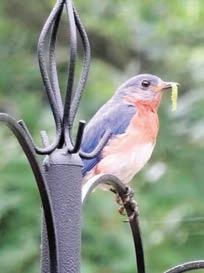
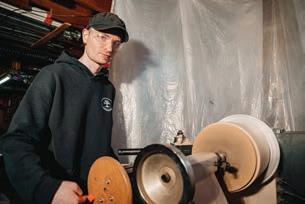
Sincerely,
Avery Lieberman Eaton averyl@chestercounty.com
Stone Lieberman stone@chestercounty.com
Steve Hoffman, Editor editor@chestercounty.com
Cover Design: Tricia Hoadley Cover Photo: Richard L. GawThe Bluebird Society of Pennsylvania’s mission is to protect bluebirds and other native birds that need enclosures. The organization encourages homeowners to join them by constructing small nesting boxes in their yardsBy JP Phillips Contributing Writer
With their deep blue backs and rusty-colored breasts, bluebirds are one of the prettiest songbirds in Pennsylvania. If a yard has an open or grassy space, bluebirds can be neighbors. It is easier than most people think.
Many local bird species build open-air nests in trees and bushes. Others are cavity-nesters, who need a fully enclosed space to lay eggs and raise their young. Natural cavities are usually found in dead or dying trees. Looking to be good neighbors, suburban homeowners usually cut them down. Because of this and increasing land development, natural nesting cavities are hard to find.
The Bluebird Society of Pennsylvania’s (BSP) mission is to protect primarily bluebirds, but also other native birds that need these enclosures. When a natural cavity is not available, certain species will use small nesting boxes. That’s why BSP encourages homeowners with suitable yards to build or buy a bluebird nesting box. Even if bluebirds are never seen in a neighborhood, over time they will find the box if it is erected in or near an open field. In our area, desirable cavity nesters that will use a box includes bluebirds, tree swallows, and chickadees.
There are plenty of open fields off Route 896, and in the housing developments that dot Oxford Road in New London. Sue and Paul Zuk have lived in one such
development for the past 35 years. The houses in their neighborhood sit on one-acre parcels with large front and back lawns. This is ideal bluebird territory.
Five years ago, the Zuks purchased a nesting box and have been rewarded ever since with the presence of bluebirds.
“It’s amazing how they gravitate to that box,” Paul said. Even during the non-nesting season (October through early April), bluebirds seem to be more in the vicinity since they installed the box.
“We’ve had a lot of bluebird activity there. And last year we had a brood,” Sue said.
Last year, Paul noticed that five babies were sitting on the garage roof and nearby trees.
“Probably three or four days, they were around. And then they kind of went their own way after that,” he said.
“We’re still trying to be more observant about their lifestyle patterns and everything, but we actually saw the babies come to this feeder,” Sue said. The Zuks have multiple feeders very close to their house so they can admire the birds.
“I think those are baby bluebirds! So, we looked them up,” Sue said.
The Zuks are learning. Even though they saw babies last year for the first time, it is likely that they have been raising bluebirds since they installed the box five years ago. It’s also possible that bluebirds use the box to roost in the off-season.

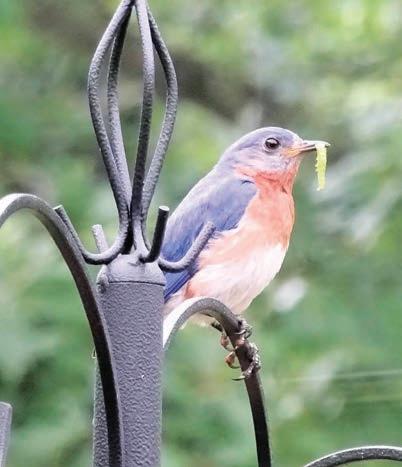
Continued from Page 8
The Zuks are new to the BSP.
“Last year we went to the Farm Show,” Sue said. “There was a table for the Pennsylvania Bluebird Society and we signed up because we love birds. We get their newsletter, and I love it.”
Many Chester County parks have a series of nesting boxes, called bluebird trails, that are maintained by BSP volunteers. During the “season,” which starts in April and runs through September, trail monitors check these boxes once a week to record nest-building progress, the number of eggs laid, and the number of babies who successfully leave (or fledge) the nests. They fix bent support poles, leaky roofs, and clean out spent nests so another pair can start the life cycle again. In October, trail monitors submit their reports to the BSP, which aids in tracking and research.
The BSP encourages individuals to have their own bluebird trail in suitable backyards, even if it’s just one nesting box. Simple building plans are on the BSP website. Boxes also can be purchased at many area stores. They should be installed in an open area, with the entry hole facing east to shield the cavity from wind and rain.
During the winter and especially in March, bluebirds scout out suitable nesting boxes. Once a pair decides on a home, females take four

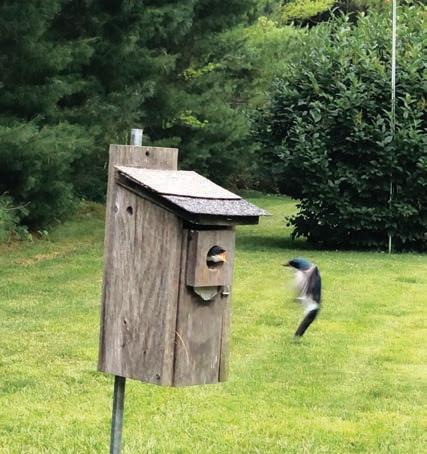


or five days to build a nest. They then lay one egg per day. After she lays all of her eggs (usually between four and six), she provides warmth by sitting on them and the 14-day incubation period begins. After hatching, babies stay in the box for 18 to 20 days. When it’s time for them to fledge, the parents stop feeding and one by one, like planes taking off at an airport, the birds come up to the entry hole and fly out of the box. They no longer need the nest, so it’s time to clean it out and hope for another round.
Just like trail monitors, homeowners should check boxes–which is really part of the fun. The Zuks were not aware of this, and have kept their distance when there was activity.
“We were worried we’d disturb them and they would fly away,” Sue said.
This is a common misconception. The birds will not abandon the nest, provided it’s only opened once per week for a short time to record progress. Sue and
Continued on Page 12
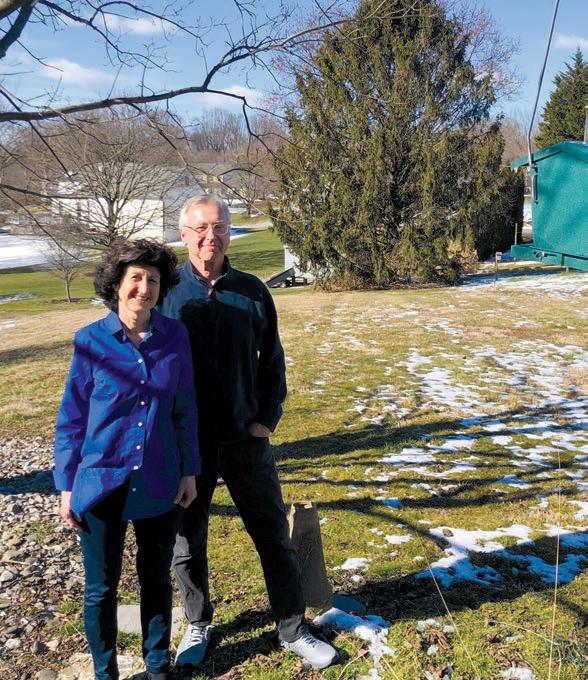



Continued from Page 11
Movie character Forrest Gump famously compared life to a box of chocolates— “You never know what you are going to get.” Opening a nesting box is similarly filled with wonder—there could be a nest, eggs, or babies. Seeing the nest will help verify which bird species moved in. Bluebirds lay blue eggs and have neat nests of pine needles or sometimes straw. Chickadees have brown-speckled white eggs and use moss, with the egg cup lined with soft white fur. Tree swallows lay pure white eggs and use straw or pine needles with feathers on top to hide the eggs. House wrens, a cute but aggressive native, have eggs similar to chickadees, and disheveled twig nests.
English sparrows, also called house sparrows, are neither native nor desirable. They have eggs similar to chickadees but disorganized straw nests.
“There were sparrows in there a couple of years ago, and we went and took out the whole nest,” Sue said. “We could tell it was a different type of a nest. We looked it up.”
They did the right thing. House sparrows were introduced from England to Brooklyn in the 1880s, and have become a real problem nationwide. They, as well as house wrens, have been known to take over bluebird nests, puncture eggs, and kill the inhabitants.
Continued on Page 14

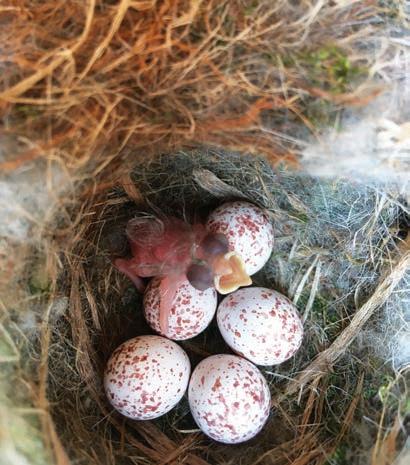
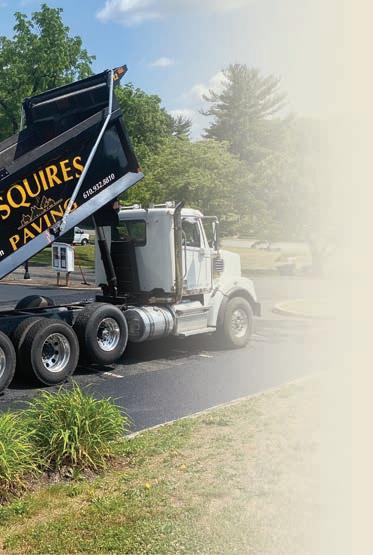





Continued from Page 12
Birds typically lay eggs in the early morning, so it is best to check a box after that. Knocking on the side of the box first is a good idea, as an incubating bird will likely, but not always, fly out (do not stand in front of the entry hole). Boxes should not be opened after the babies are around 12 days old, as it may cause them to fledge prematurely. After babies leave, they do not return to the nest. It’s time to remove it and hope for another family.
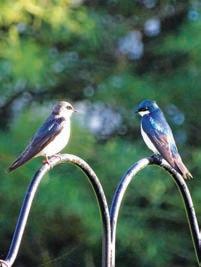
According to the BSP’s box tracking report, Chester County volunteers reported that 1,263 bluebirds (up 17 percent from 2022), 3,696 tree swallows, and 413 chickadees fledged from monitored boxes in 2023. People checking boxes and reporting results help the BSP track trends and anticipate problems. Homeowners like the Zuks help keep native birds thriving.
“I’m excited to check this box every week,” Sue said.
The Pennsylvania Bluebird Society welcomes new members and volunteers. Bluebird nest box building plans and other information can be found on their website, www.thebsp.org.















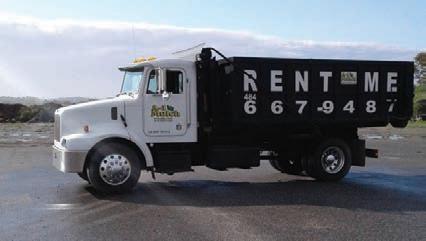
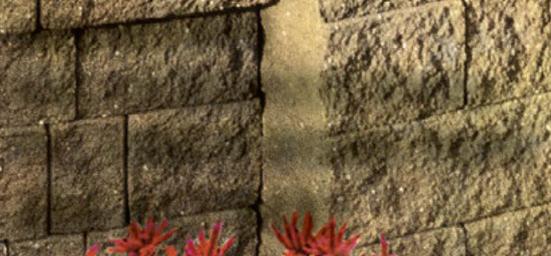
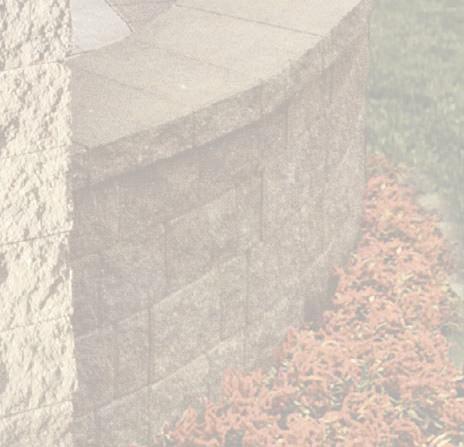
Throughout our lives, the sources of what serve to inspire us arrive in several forms, from the human to the inanimate, and from moments to milestones and everywhere in between.
As Andrew Skrabak enjoyed what would become a 12-year career in food and beverage operations – which included a stint at Herr Foods – he stored an idea in his mind that saw him merging his professional experience and his entrepreneurial spirit with an industry that has drawn dreamers by the thousands in recent years.
The grand sketch of his idea – to begin his own specialty coffee roasting company – stayed with him as his career progressed from developing products for Stonyfield, the organic yogurt manufacturer, and then to Portland, Maine, where he spent a few years overseeing new product development for a coffee franchising company.
Born in Cochranville, the tug of southern Chester County and the clarity of his career aspirations were becoming too hard to resist, so together with his wife, Brittney and their young daughter, Ruth, Skrabak moved to Landenberg, and in April of 2023, he launched Creekside Coffee Roasting Company.
“Having the intersection of what I did professionally and my ideas as an entrepreneur dovetail, I began to realize that coffee was the perfect marriage,” Skrabak said recently at the Landenberg Store, one of ten locations where the company’s products are supplied and sold. “Coffee is one of the unique areas of the food industry where there is so much to learn and so many ways to learn. When I was working for the coffee franchising company in Maine, I got to learn the science of coffee, how it translates to sensory attributes, how to source it and roast it and brew it and how to serve it well.”
Through his partnership with Royal New York, Creekside’s products are mainly sourced from family coffee farmers in Costa Rica, Honduras and Brazil. Skrabak prepares coffee at the Landenberg Store using a roasting machine known as the San Franciscan (SF-6) that is equipped to roast small batches to better ensure premium quality.
While the primary technology used to roast Creekside’s products appears “Old World” in its design and function, the growing industry of organic and fair trade coffee is far from outdated. In 2022, the global market for specialty coffee was valued at nearly $22 billion and is projected to eclipse $51 billion by 2030.
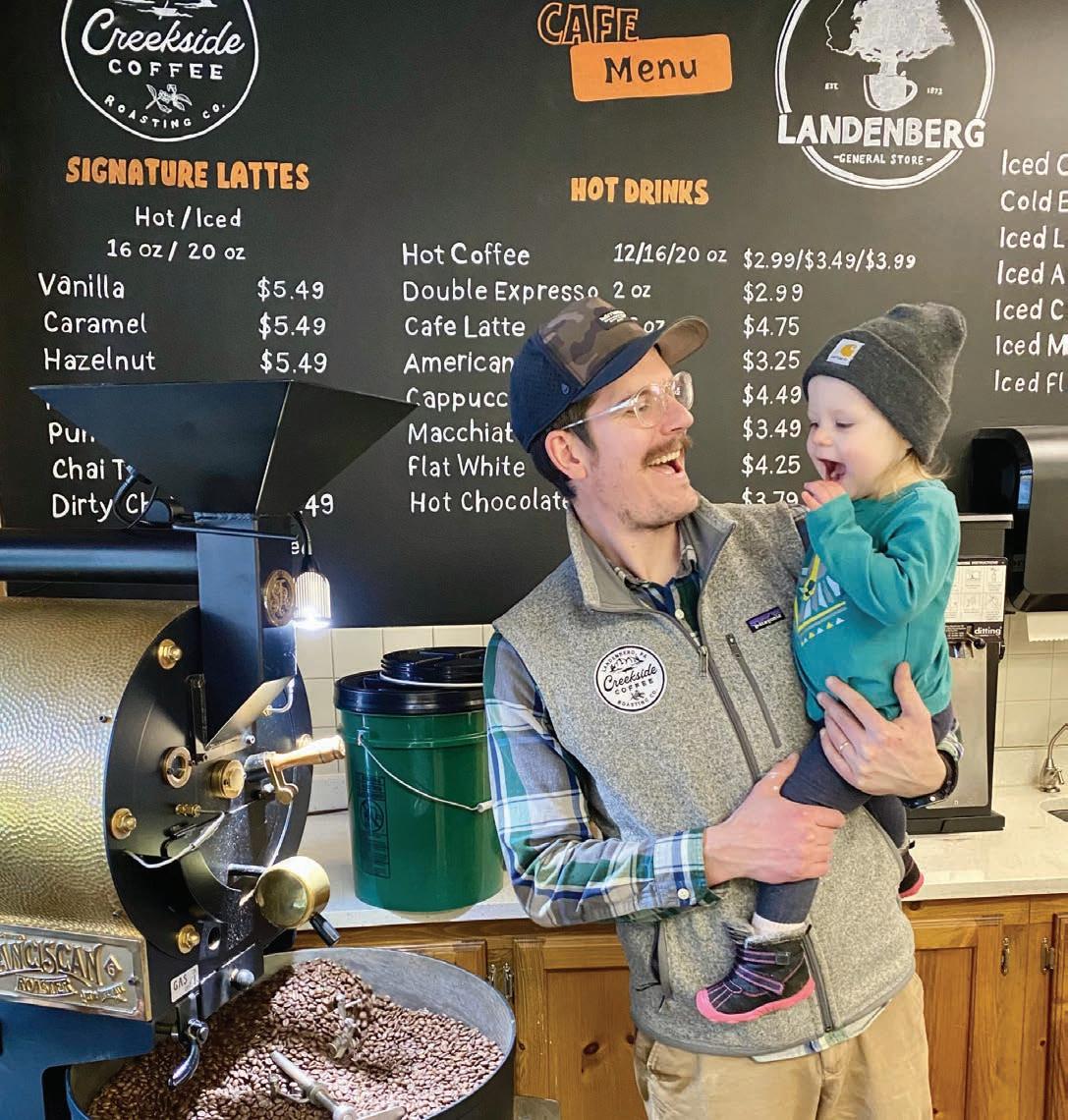
Continued from Page 18
“The growing demand for specialty coffee can be attributed to a variety of factors, including the desire for high-quality, flavorful coffee experiences, and increased awareness of ethical and sustainable sourcing practices,” Skrabak said. “As coffee culture continues to thrive, consumers are seeking unique experiences, with specialty coffee shops and cafes serving as popular social destinations.
“Coffee used to just play a role that provided its consumers with energy and a spark, but eventually, some early pioneers in the industry realized that if you place value on how you source, process and serve this product, it can become something not just to be used as a utility, but as a product to be enjoyed in the same
Continued on Page 22
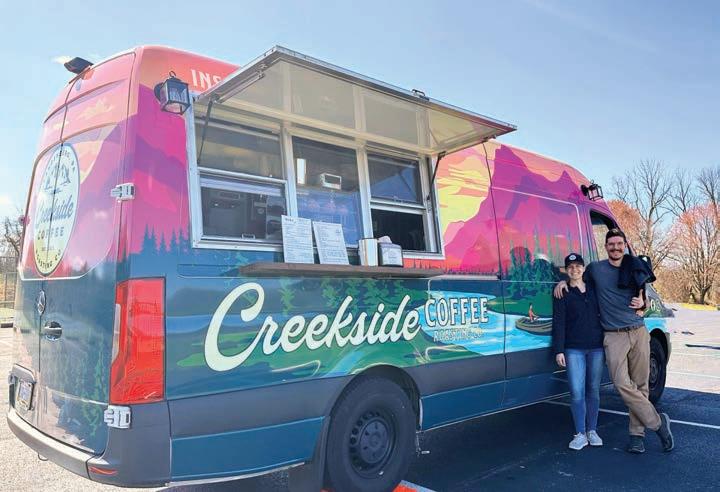


Continued from Page 20
way that food has been. There’s a new emphasis on local production and quality products, and a consumer base that appreciates those two things. I view the role of other local roasting companies in our area not as competitors, but as comrades. We’re all fighting the same giant, not just for the consumer’s dollar, but for their appreciation.”
Skrabak’s aspiration is to expand his company to other markets throughout the region, a process that will be made easier through the recent acquisition of a mobile coffee van that will enable him to appear at public events. Woven within these plans, however, will be the motivation to share the other half of Creekside’s mission -- an intangible one, far removed from the science of preparing sustainable, environmentally friendly coffee.
In fact, is written on his business card: Inspire Others.
“I launched the company because I thought that I had the ability to connect with people and inspire them to do what makes them happy,” he said. “I view myself as a potential tool to help and inspire others to pursue their own happiness, whatever that means for them.”
To learn more about Creekside Coffee Roasting Company



and to place your order online, visit creeksidecoffeeroasting.com, email andrew@creeksidecoffeeroasting.com, or call 610-952-8645.
To contact Staff Writer Richard L. Gaw, email rgaw@chestercounty.com.
Continued on Page 24



Continued from Page 22
Blue Barn Farm at Shah Valley, 2819 Blue Ball Road, Elkton
The Coffee Trailer at 5 Points Junction, 314 Chrome Road, Oxford
Hangry Bear Creamery, 660 East Cypress Street, Kennett Square
Hood’s BBQ, 1664 W Doe Run Road, Kennett Square

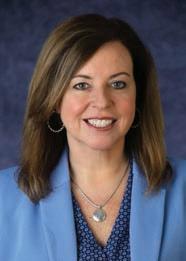
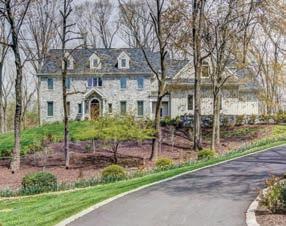

The Landenberg Store, 100 Landenberg Road, Landenberg
Neuchâtel, 461 Limestone Road, Oxford
North Star Orchard, 3232 Limestone Road, Cochranville
Sunny Day Play Café, 747 W Cypress Street, Kennett Square
Yellow Mug Café, 125 Saginaw Road, Lincoln University








If it’s not purple, Regina Fees isn’t interested.
While an exaggeration, various shades of her favorite hue are seen throughout her Landenberg home, whether it be in the form of a toaster, curtains or objets d’art. She said even when she was a baby, the best way to get her attention was to show her something that was purple.
Colors are important to Fees, as are shape, texture and function. The artist and teacher, whose imaginative instincts stem from a family tradition swathed in lace, thread and yarn, has carried on the custom with her ceramics work. Her Three Tuxedos Pottery Studio is based in Fees’ historic home, the Lamborn House, in New Garden Township Park.
Fees, whose enthusiasm for her work is clear, elaborated on how her parents influenced her creativity.
“My dad was a weaver for Quaker Lace (Company). He was a designer for 32 years,” she said. Her late father, Richard Fees, was director of design at the Philadelphia business. “Any of the patterns that you see are usually my dad’s. He had over 200 patents. They were registered under Quaker Lace, but they were his designs.” Her late mother, Lilyann Fees, was a seamstress and a quilter.
Fees herself has a long personal history in the functional arts. And performing one, she said, just dovetailed into the next.
“I just love pottery. I love the fact that you can dig earth
out of the ground and make it into something usable and beautiful. I was bitten by the bug a long time ago,” Fees said.
She explained how she started. In 2007, and then a teacher at a Philadelphia charter school, she had a vacation house in Lake George, N.Y. and would give fiber arts demonstrations during textiles shows. “I was really into knitting. I was really into crocheting and I got into spinning so I ended up making my own yarn.”
Fees laughed. “I’m an artist,” she reflected, “I just can’t make up my mind. I don’t know what I want to be when I grow up. I was dabbling.
“I knitted myself a shirt with my own fiber. It looked very primitive in a really cool way, so I couldn’t put plastic buttons on it, but I couldn’t find a button that I wanted. So, I just got some clay and I made myself buttons.
“Then I put the buttons on and I did the demonstration in the convention center and I’m spinning and lo and behold, there’s a quilt show upstairs.
“There are ladies coming in (from the quilt show) and they’re looking at my stuff and they’re watching me spin and we start a conversation. One woman comes up and I thought she was looking at my shirt that I made. She was looking at the buttons and asked me, where’d you get these buttons? I told her I made them. So, she’s talking with some other ladies and she comes down to me and she says, ‘I own a quilt shop in Glens Falls (N.Y.). Would you be interested in packaging them so I could sell them at my shop?’
Continued on Page 28

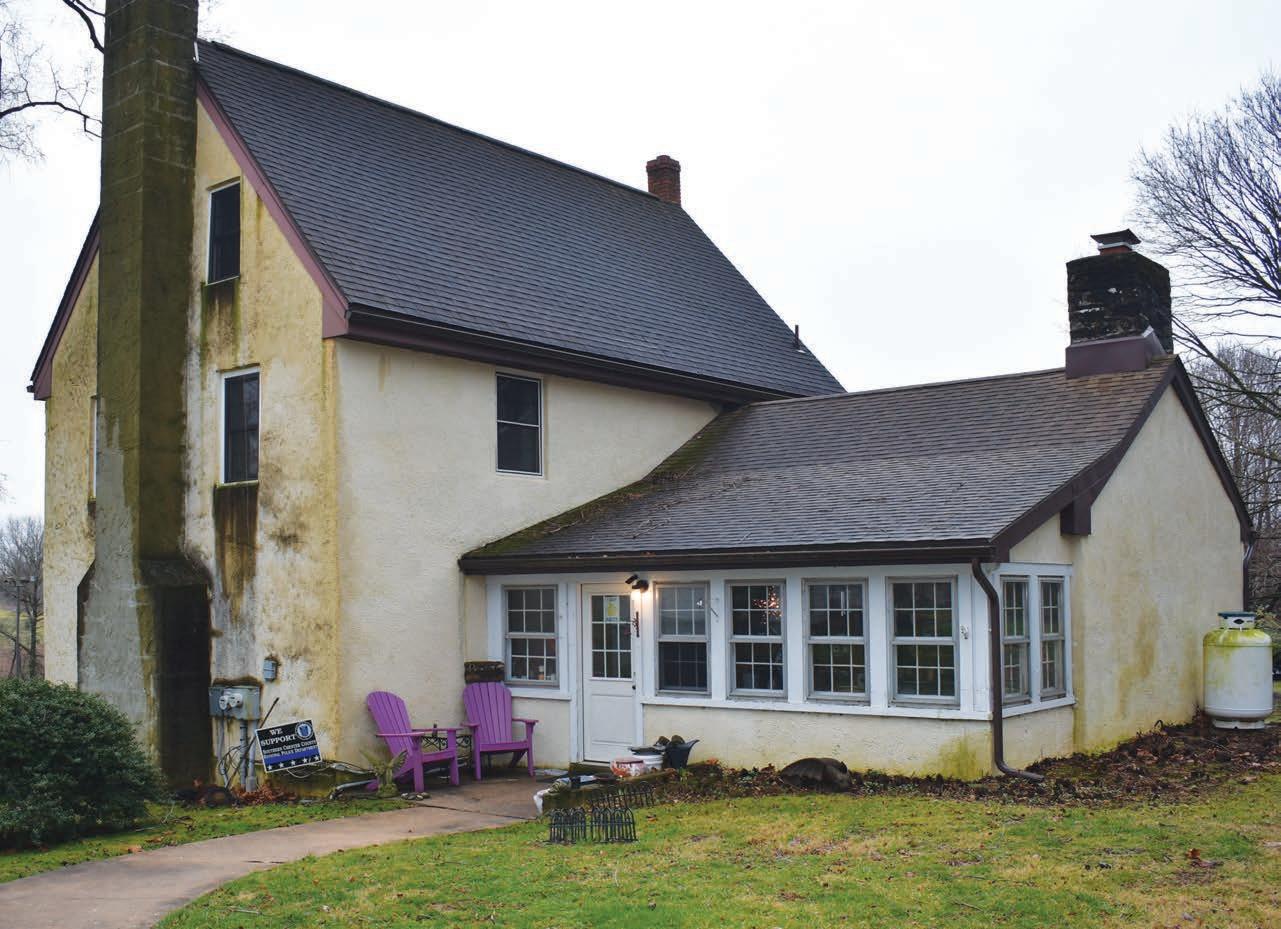 Photos by Natalie Smith Lamborn House, the 1804 building at the entrance to New Garden Township Park, is the home of artist and teacher Regina Fees. Fees’ Three Tuxedos Pottery Studio is also there.
Photos by Natalie Smith Lamborn House, the 1804 building at the entrance to New Garden Township Park, is the home of artist and teacher Regina Fees. Fees’ Three Tuxedos Pottery Studio is also there.
Continued from Page 26

“That’s how it started. I called them Adirondack Nature Buttons. It was all reclaimed clay and reclaimed glaze that I would get from school but ended up in the trash bin. I would trash pick it, reclaim it … from kids dropping it on the floor it would get hair and all kinds of nasty stuff in it. You soak it and you bleach it to make sure all the impurities are out and then you sift it to make sure there’s no rocks, bottle caps or whatever in it.
“After you do that, then it’s hard to hold its body, but it’s really easy to roll it out flat and make ornaments and buttons.”
Among its wares, Three Tuxedos Pottery sells stoneware mugs, small plates, ornaments, buttons and vases. The mug sizes are each named for one of her three tuxedo (black-and-white) cats, with the newest family member, a fluffy black feline, added to the mix. Abby is the smallest cat, thus the smallest mug holding 8 oz., then the Jessy at 10-12 oz., going up to the

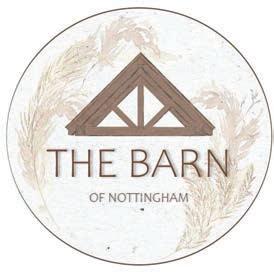



Morgan at 14-18 oz. The Simon mug, named for the coal-colored puss, is an in-between at 12 to 14 oz.
Fees will also do custom work, and proving very popular are her car-themed mugs. She continues with buttons, of course, which she has produced by the hundreds. Her sister, Ruth Raisner, makes quilted handbags under the name of My Sister’s Bag, and Sis uses Fees’ buttons.
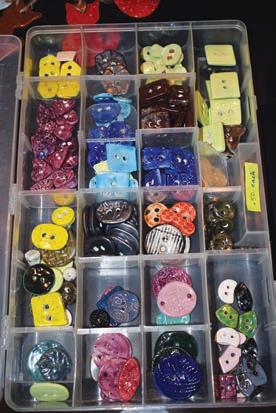
“When we did shows together, we’d cross sell,” Fees said. “If someone likes my buttons, I’ll say, oh, you need to see all my sister’s bags and then I send the people over there. And if people are looking at her bags and I’ll have like a baseball button on her baseball bags. And they’ll say, what cool buttons. She’ll say, ‘my sister made them. She’s next door. She sells pottery.’”
The Kennett Square Mushroom Festival is also a highlight of her year. She sells mushroom-shaped ornaments and festooned mugs.
“I’m the only one with a purple tent,” Fees said, identifying a way to find her space. “I also sell pins and magnets of all mushrooms. I try to have stuff that anybody can buy, so little ornaments for $3 or $5.”
She also donates her work. For the nearby Treetops Kitty Café-Cat Adoption and Visitation Center in Kennett Square, she created a stamp with its logo.
“I make ornaments for them so they can sell them,” she said. “I’m a teacher, so I don’t really donate money. But what I can donate is my skill and my craft, so they can sell them for money. And it’s also something cool for them to have.”
At Avon Grove Charter School, Fees teaches a host of art classes to the high school students, including Pottery, Fiber Arts, Drawing, 2D and 3D Design. She also teaches Intro to Business and Intro to Marketing as an adjunct instructor at Immaculata University.
“Juniors and seniors can take entry-level coursework and they have three college credits before they graduate high school,” Fees said.
Continued on Page 30
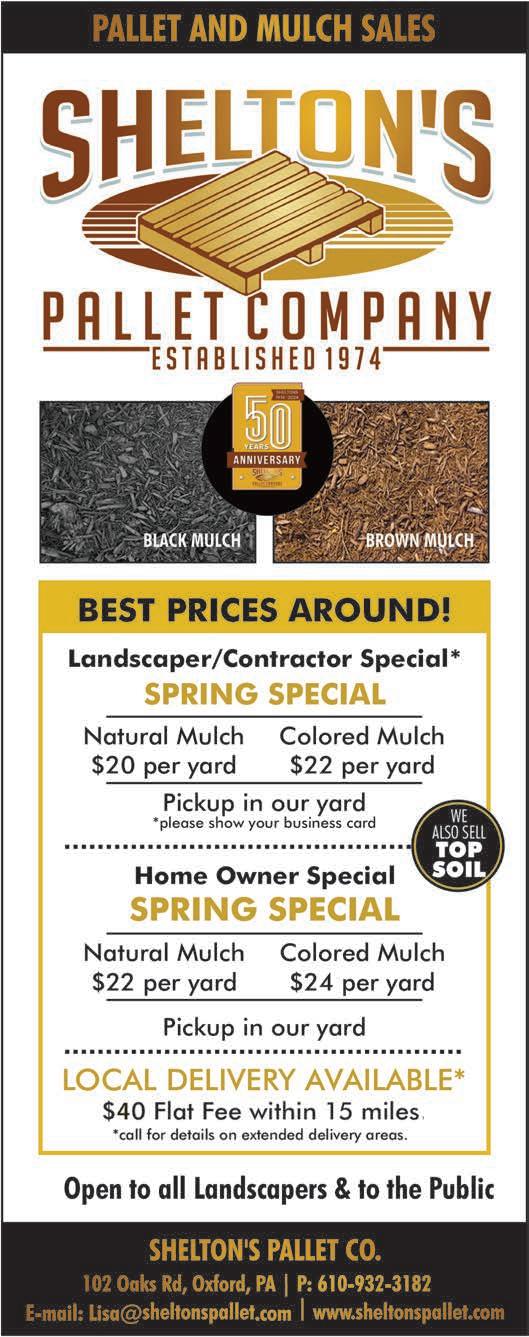
Continued from Page 29

Fees said that she has enjoyed working with her students at the school since she began in 2016.
“They have a micro farm there with sheep and alpaca, and so I have unlimited access to fiber,” she said. “They didn’t have a fiber arts program, so I started one.”
In January 2020, some students participated in the Pennsylvania Farm Show event. Calling themselves “The Spinsters,” these students wove a shawl from scratch in three hours.
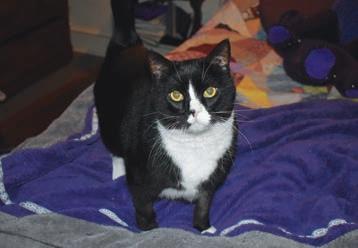
“It was a competition that’s called from Fleece to Shawl,” she said. “Normally with adults, it’s Sheep to Shawl. The adults bring their own sheep and they have a shearer who’s part of the team. You have to have a five-member team and the sheep and the shearer are members six and seven. So, with us, we had a fleece that we had already sheared. Everybody had their fleece and what they did was they card (disentangle and clean) it, then we get spinning
Continued on Page 32


Abby



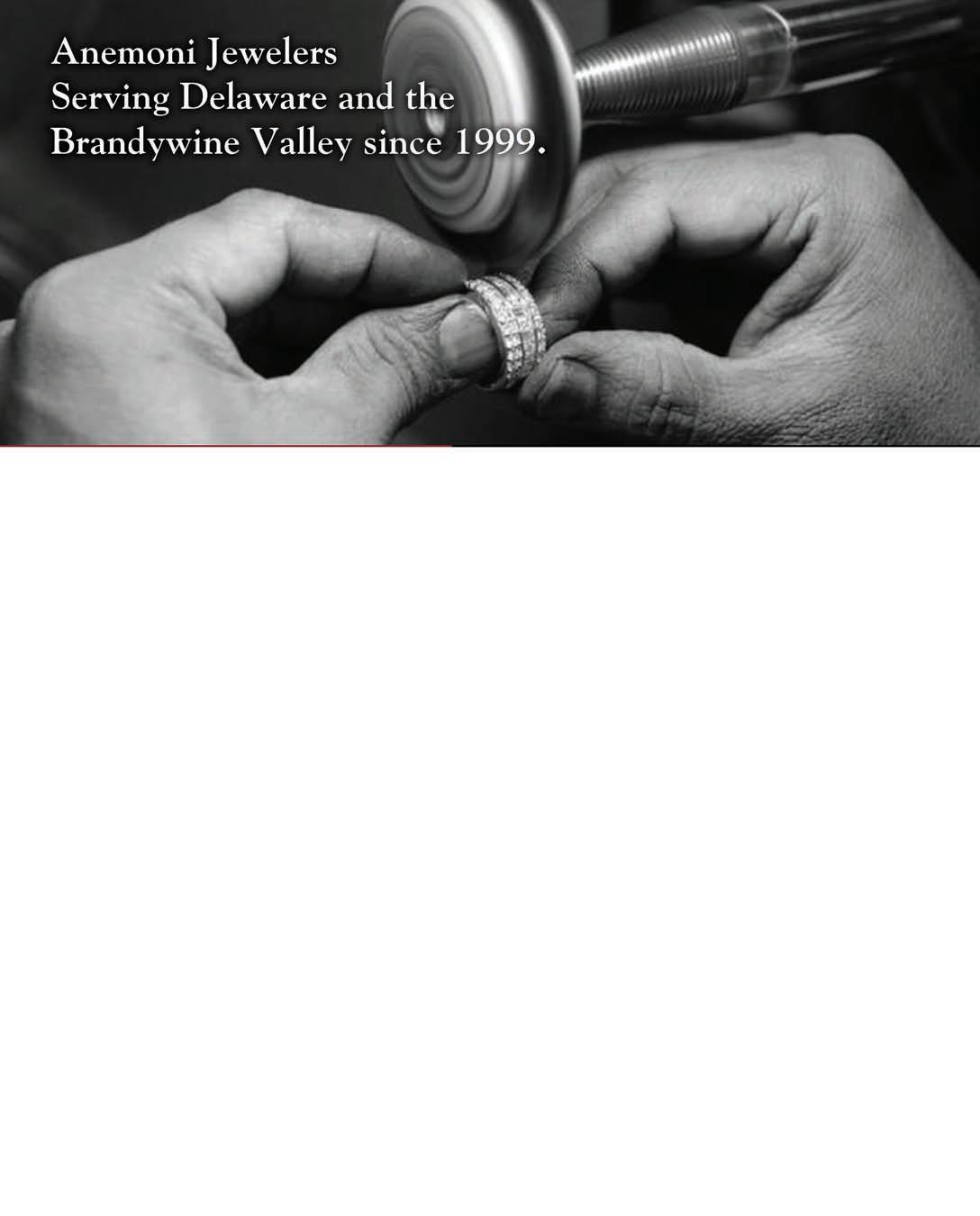
Continued from Page 30

wheels and start spinning it, then we got weaving looms and then weave it and then that’s what they came up with.
“Unfortunately, it had to be certain number of inches and I think we were about 6 inches short; we ran out of time. So, it was disqualified because it didn’t meet the minimum requirement.
“We knew we weren’t going to make it. I said to the kids: ‘Do you want to keep going and finish it knowing that you’re going to be disqualified? Or do you want to just go home early or walk around the farm show? It’s completely up to you. This is your experience, not mine’. They wanted to finish.
“They handed it in, and even though they didn’t place in the top, we ended up coming home with over $300 in checks because they got Best Fleece and won in other categories. I was super proud of what we had done. It was so much fun.
“It was just a really, really positive experience.”
In her home, the enclosed porch serves as her pottery studio. It’s fitted with a small kiln, shelving units and a potter’s wheel. The wheel is unusual in that Fees stands while using

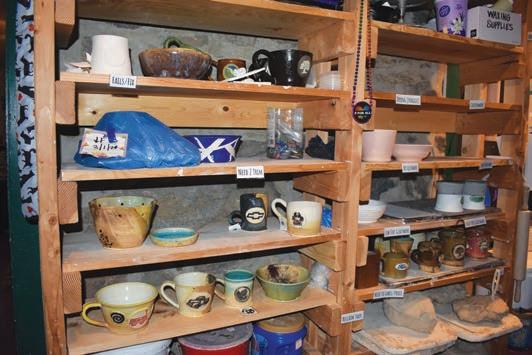
A shelving unit that Fees built in her studio.
Continued on Page 34 it. “I started to have some hip pain, and this was before I lost weight. I saw an article where somebody put their wheel up on blocks and they stand. I’ve been standing ever since so my wheel is elevated, which is pretty cool.”








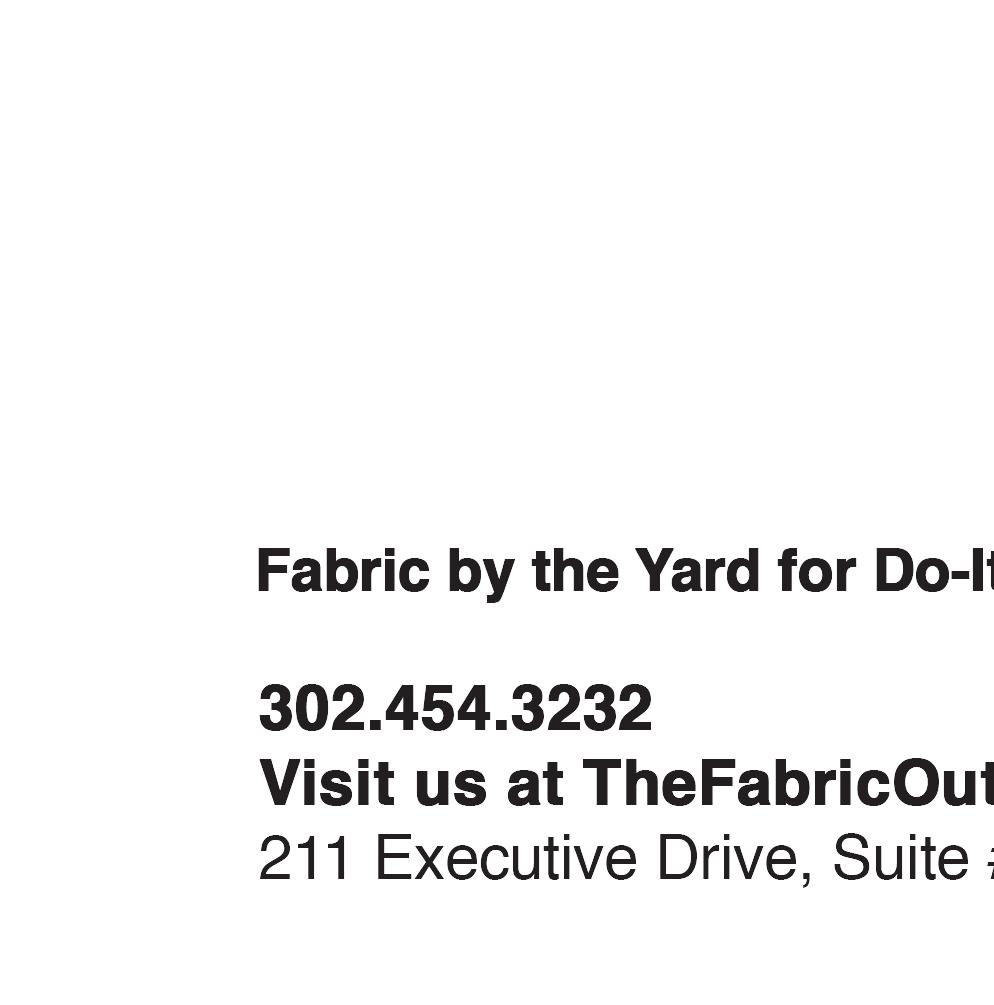





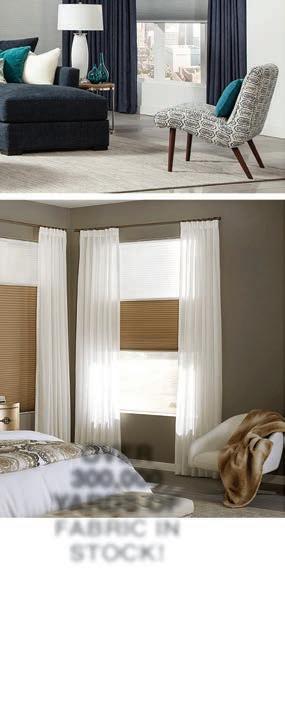
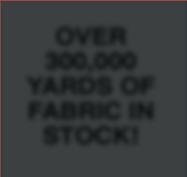


Continued from Page 32
She said her transition to pottery was just the next step in her artistic development.
“When I got my hands on that pottery wheel, it was something I always wanted to try because it looked cool. I’d go on YouTube and I just watched videos and thought, I want to do that. Then I got my hands on this pottery wheel -- this beautiful 2½-horsepower old pottery wheel. It’s like an ancient horse. It won’t die.
“You get to a certain point where you can center (the clay on the wheel) easily and then you can just pull up the wall (shape the object). It gets to be so much fun because

you can make anything then. I just watched a video, then I made this vase and just took a tool and dragged it up the side to make little fluted edges. It was that easy and you have this really interesting little thing.”
“When I get into it, I get into it fully,” Fees said, about her devotion to the various functional arts. “I just started falling in love with a pottery wheel.”
More information about Three Tuxedos Pottery Studio is available at threetuxedospotterystudio.com.
Natalie Smith may be contacted at natalie@DoubleSMedia. com.










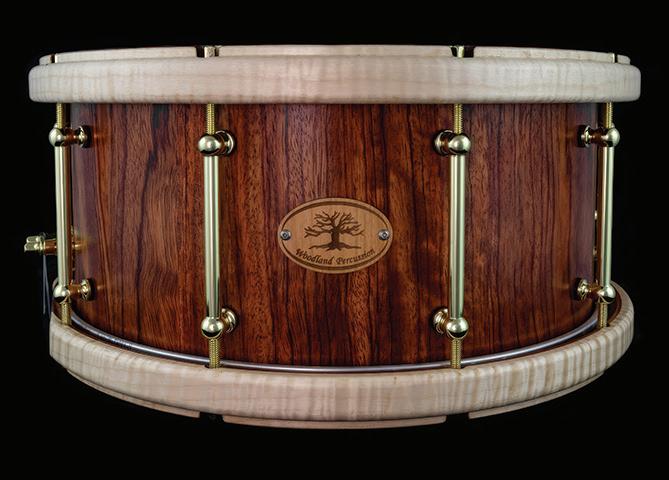

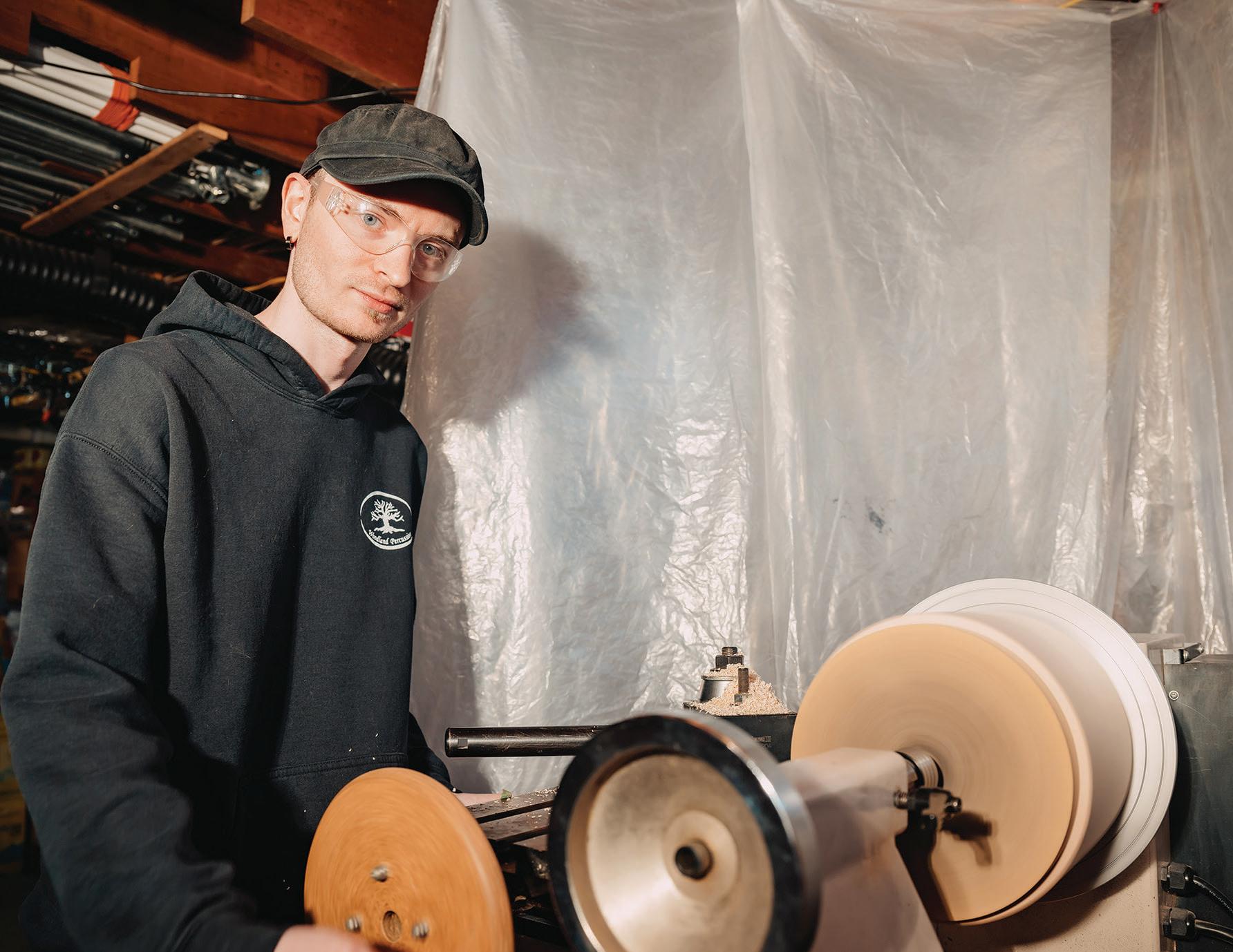
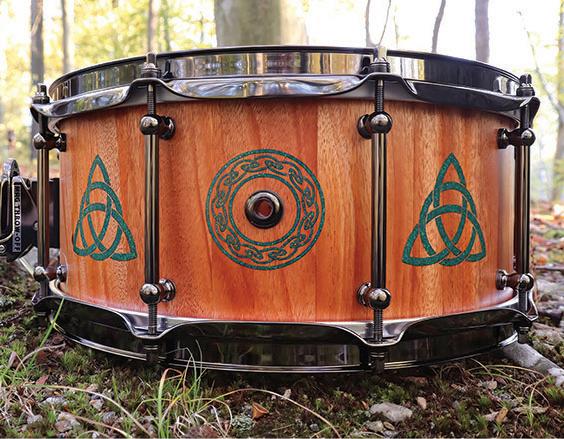

For the past several years, Allan Fausnaught has followed his talent and inspiration to handcraft one-of-a-kind musical instruments and functional art. As a result, his Woodland Percussion and Woodland Woodworx pieces are now in homes, in music studios and on stages around the world.
Continued on Page 38

Continued from Page 37
Allan Fausnaught literally grew up on a construction site – the home he grew up in on the outskirts of Landenberg that was partially built by his father -- so it seemed preordained that Allan’s life would be one generously blessed with the ingenuity of craftsmanship.
Under the tutelage of his father, among the sawdust and the router bits and the mitre saws, he melded the passions of his childhood – music and art – and after entering Penn State with a major in Mechanical Engineering, he began to turn what was once a hobby into a career decision.
In August of 2015, the 19-year-old Fausnaught brought two handmade snare drums he had made to Dale’s Drum Shop to meet John Good, the vice president of Drum Workshop, one of the largest drum companies in the world, who was given the nickname “The Wood Whisperer” by legendary Rush drummer, Neil Peart.
“John looked at my drums and said, ‘You did this? You keep doing what you’re doing. This is art’, and the drums were put on the shelf for sale,” Fausnaught said. “That was the spark I needed.”
Continued on Page 41

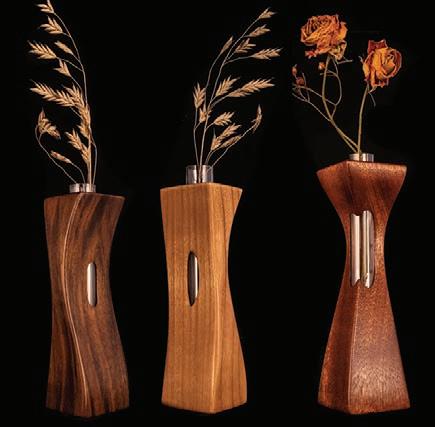


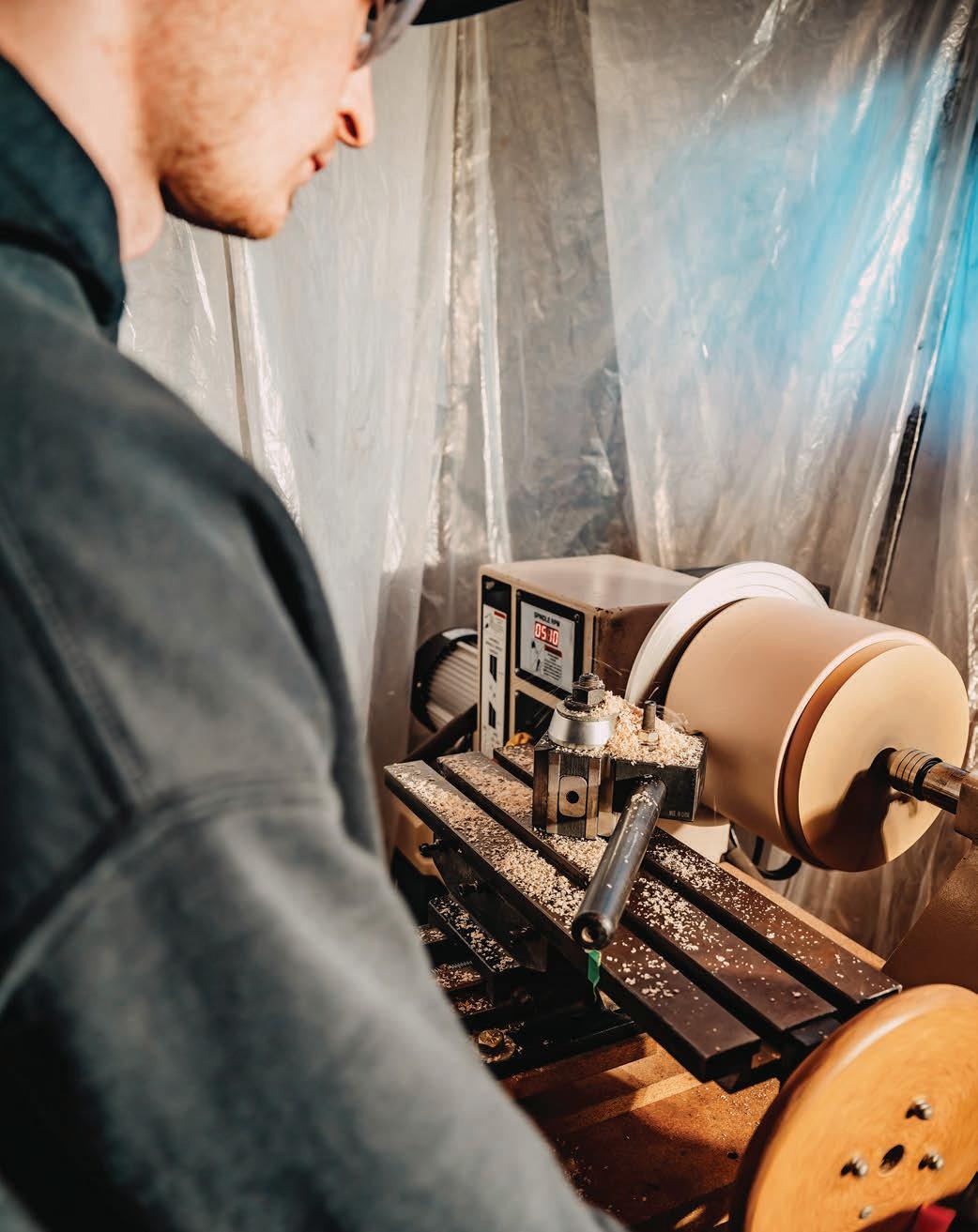

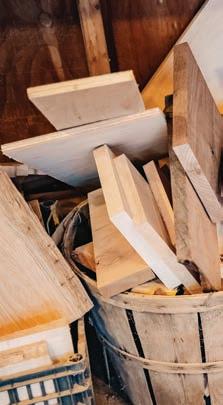




Continued from Page 38
Woodland Percussion, a decision that saw him begin to work with A-list recording artists, session musicians and touring bands. By the time he graduated from college in 2017, Fausnaught had already made connections in the music industry and established a small but loyal customer base.
“I think I’ve drawn interest from the music industry because of my obsession to detail,” Fausnaught said. “I try to do things that are not normally seen and that no one else is doing. I am open to unique projects, and I have unique methods to put on the table that says to my clients, ‘I am hearing your ideas and here is what I can do, so let’s meet and create something that is a quality and artistic piece.’”
Using that same attention to detail – a balance of woodworking, engineering and artisanship -- Fausnaught began Woodland Woodworx in 2018. It is the second chapter of a professional career, a stunning catalog of hardwood spun into individual pieces that utilize engraving, carving and esoteric design. Fausnaught’s art is displayed in galleries, artisan shows and in homes.
“If I have a creative idea, I can take it as far as I want,” Fausnaught said. “Just because I am limited because of the size of the machines I work with, I don’t let that limit me to the possibilities, because every time I think that I can’t do something, a few months later I am doing it. Every piece I create becomes a self-challenge, a push to be different.”
To learn more about the work of Allan Fausnaught, visit www.woodlandwoodworx.com and www.woodlandpercussion.com.

 By Caroline Roosevelt, Contributing Writer
By Caroline Roosevelt, Contributing Writer
Recently, I had the opportunity to sit down with husband-and-wife Tim Bolt and Mary Schleuter at their new restaurant, The Haven Social in Landenberg. Owners of Great Big Jerk & Full Circle Food, Tim and Mary have brought their ample restaurant experience to The Haven Social and given it a diverse menu of great food and mocktails and a cool-vibe ambience. I sidled up to the restaurant’s well-appointed bar to ask Tim and Mary about the inspiration behind their ambitious and well received BYOB restaurant.
Landenberg Life: How did the two of you meet?
Mary: We both worked in the restaurant business. We worked at two different restaurants in the same group and ran in the same circle of friends. We met back up down the road a couple years later at a different restaurant group and started dating in 2013.

You both have extensive backgrounds and experience in the restaurant industry. What brought you to Landenberg?
Mary: I was born here and Tim started our meal delivery business, Full Circle Food, here. The business started out of our home kitchen, and I ended up “evicting” him with some notice because my clothes were starting to smell like a restaurant’s kitchen. We were at a birthday party at our current location for my friend, and at the time we were looking to find a commissary kitchen, so my friend gave us a tour and we said, “This is perfect!”
Continued on Page 44
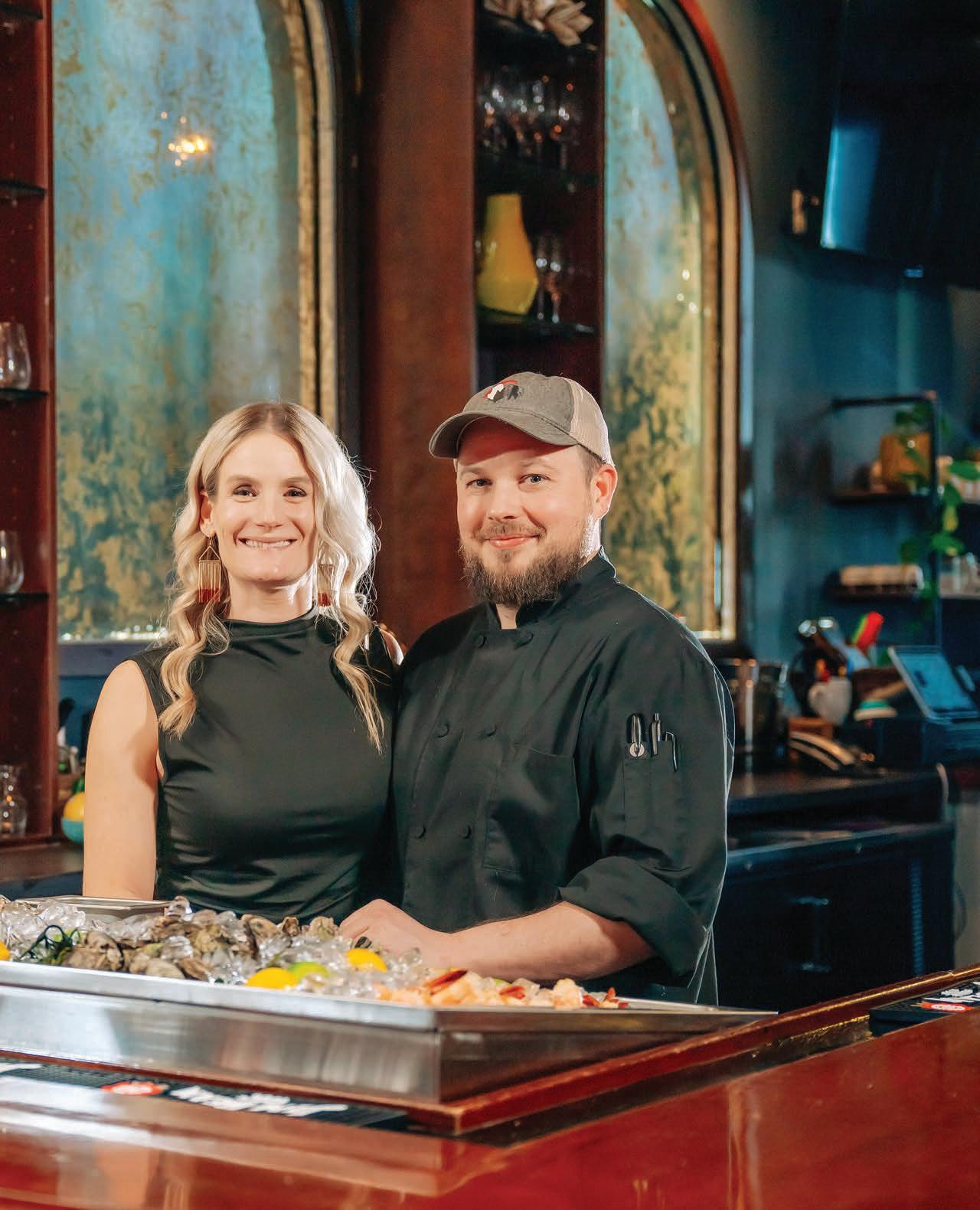
Continued from Page 42
We got the owner’s number, and even though there was work that needed to be done, Tim set out on a mission to get the place ready for operation. One year into Full Circle Food we started renovating the unused dining area into an event space until COVID-19 shut that part down. Full Circle remained open during the pandemic and Tim opened Great Big Jerk, a roadside BBQ operation because many restaurants had to close their doors. It flourished and has since found its own location!
When did The Haven Social officially open?
Mary: We officially opened before Thanksgiving. Tim and I were talking late one night before bed about a crazy idea to quickly transform the space into a full-blown BYOB restaurant. A week later Tim had built a website, ordered
furniture and proceeded full steam ahead to open. A week later we were ready.
Tell me about the inspiration behind your menu.
Tim: I am inspired by the East Coast. I was born in Virginia and went to school at the Culinary Institute of America in Hyde Park, N.Y. along the Hudson, and all throughout, I’ve always loved seafood. Years ago, I was the Sous Chef at Deep Blue, an upscale seafood restaurant downtown and then as the Chef behind the opening of an oyster house in Wilmington, I fell deeper in love with the casual seafood concept. I really wanted to add the raw bar aspect in my own location as well as my seafood favorites like lobster rolls and mussel pots, which are on the menu at The Haven Social.
Continued on Page 46


Continued from Page 44
Guests at The Haven Social have many options from raw bar – such as yellowfin tuna tartare and oysters -- to oven-baked flatbreads to small and large plates. By the way, your lobster roll is delicious, and it compliments your entire menu, which is eclectic but not fussy. Talk about the approach you wished to take with The Haven Social’s menu.
Tim: I wanted The Haven Social to showcase approachable food in a fun, social atmosphere. That’s the whole point of this – great ingredients, proper cooking techniques and hangout vibes. For those in Landenberg who read this article, the feeling of being at The Haven Social is the feeling of being on vacation without traveling far from home.
It feels like the lobby of a big-city hotel – as if you’re having a drink and a bite to eat at the cool bar area before heading up to your room.
Mary: That’s the vibe we were aiming for – transporting you out of Landenberg for the evening without having to actually leave Landenberg.
Tim: When we opened Great Big Jerk here during the pan-
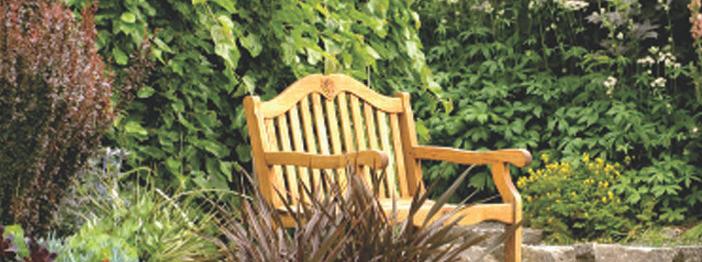



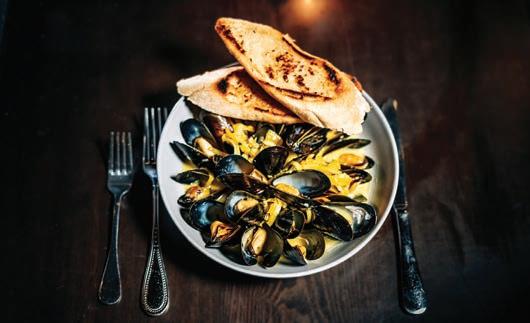
demic, we had a pickup window inside our event space, and customers were requesting to eat their meals inside, so we put butcher paper on the tables and welcomed them to enjoy their meals in the event space. It was disjointed from the start and was never meant to actually stay Great

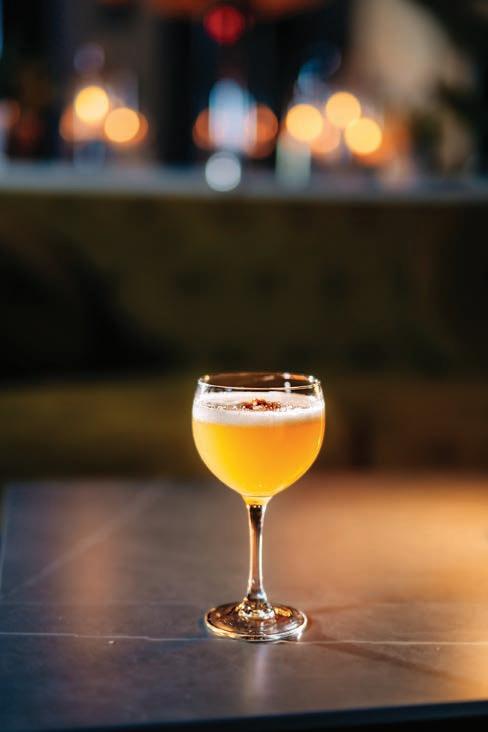




Big Jerk. I was always shifting things around for a farm-to-table event, or a baby shower, but inevitably, and from the start, we had always envisioned being full service with swanky décor and the chill vibe ambience we have now.
So you were able to create the atmosphere from the start?
Mary: Yes. The event space was the foundation, but we have definitely fine-tuned it. The green couches were originally for the lobby of the event space but now are the focal point of our lounge style seating areas. We love having a fire burning outside the front door. Each little piece of our ambience are personal touches we enjoy when we dine out. At some point it would be really cool to have our own curated line of scents/ candles that align with our concept.
One of the first sensations I felt when I walked in was the delicious scent of orange. What made you focus on a particular scent?
Mary: We wanted to elevate the space and create a more upscale environment.
Continued on Page 48














Continued from Page 47
Tim: The truth is that Mary was tired of the place smelling like jerk chicken all the time! Mary: That’s so true. I would have to “sage” everything in the dining area in preparation for an event because we wanted the ambience to be its own.
I love your zero proof mocktail menu. I’m surprised I haven’t seen more restaurants adopt the BYOB-mocktail culture that you have here at The Haven Social.
Mary: We really enjoy doing that and put thought into the mocktails and atmosphere. We created a sort of BYOB with a twist! We have always allowed BYOB in the past with the space, but we decided to take it to the next level and make amazing mocktails with the new concept. A liquor license in this state was one of the hurdles to face but we knew that it had to feel like a full-blown restaurant. It was a huge gamble doing the BYOB that many do not take but our thought was if the food is amazing and the ambience is unique, they will come, alcohol or not, and they have certainly come, and it’s been amazing.
Continued on Page 50








Continued from Page 48
So explain how your mocktail menu works. Guests have the option of enjoying a mocktail, or they can bring their own liquor and spirits, and check the menu to see what pairs with what?
Mary: Yes. You bring your own, and we have everything here to make what you’re looking for. Bring a six pack of beer, a bottle of wine or a bottle of booze. We place jiggers on the table and offer our recommendations to our guests on how much alcohol to add to our mocktails. They stir them up and enjoy. We are all professional bartenders with a fully stocked bar ranging from different bitters, ice spheres, mixers and Amarena cherries. Whatever you could order from a regular restaurant’s bar we are able to mix up here. All you need is your booze!
The Haven Social is located at 1215 New London Road in Landenberg and is currently open Thursdays through Sundays. To learn more and to make reservations, visit www.thehavensocial.com or call (484) 720-8552.




Down a ways from “downtown” Landenberg, in a converted olden-day schoolhouse nestled in a wooded hill within a walking distance from the roving, burbling White Clay Creek, lives a potter named Jenny Wood.
She works out of a tiny room that contains little more than a table and chairs, a pottery wheel, piles of clay, and some simple tools, but when she enters that sparse room to work on her pottery, she and every object she touches comes alive. The space becomes electric with energy, an epicenter of sparkling creativity. It is the spot where Wood simultaneously loses herself and feels most present, in touch with the marrow of everything.
“There are endless possibilities with clay,” she exclaimed. “I love to just continue to evolve.”
Wood discovered her life’s work when she signed up for a pottery class in 2012 while living in Austin, Texas. The studio was down the road from her sons’ preschool, so the class seemed a good way to while away time until she had to pick up the kids.
“My first pieces were terrible,” she said. “But I didn’t care, I was amazed with the process and the fact that I had made something.”
Wood and her family eventually settled in Landenberg, and she is not the first potter to call this locale home. In the early- and mid-1700s, many potters put down roots in Landenberg because the area is rich in white and red clays, from the aptly named White Clay Creek and Red Clay Creek. Potters were in high demand because people during this time period before the Industrial Revolution depended on them to supply drinking and eating vessels and bricks.
After the dawn of the Industrial Revolution, in the early 1800s, pottery factories with large-scale, gas-powered kilns that utilized Landenberg clays existed throughout Chester County. Also during the 1800s, kaolin, a type of clay that forms from millions of years of granite decomposition, was discovered and harvested from Landenberg’s hillsides. The kaolin was transported to Philadelphia, where it was shipped to England to produce fine china.
A book, Potters and Potteries of Chester County, Pennsylvania by Arthur E. James, first published in 1945 and republished several times since, chronicles over a hundred years of pottery history in Chester County. This book has been the bible of pottery research nationally, and it has inspired other writers to document the pottery history of their regions. The book is filled with humor and local anecdotes, so it makes for enjoyable reading for both potters and non-potters alike.
In more recent years, a very famous potter, Bernie Felch, lived in Landenberg. In fact, his home and studio were right down the street from where Wood lives now. She never knew him, however, because he died before she moved to the area.
In addition to being a potter, Felch was also a painter, sculptor, and ceramist. He served as chair of the Fine Arts Department at Lincoln University in Oxford for 21 years, and he taught pottery classes and workshops all over Pennsylvania and Delaware. His clay creations have been exhibited in museums, corporations, and universities, including West Chester University. Two of his large-scale brick works are part of the permanent collection installed in the Delaware Art Museum’s sculpture garden.
Continued on Page 54

When asked which aspect of pottery she loves the most, Jenny Wood replied, “I love everything about it, starting with visualizing a piece, then the feeling of the wet clay in my hands, and especially, the rhythm that develops when I’m working with the clay on the wheel.”

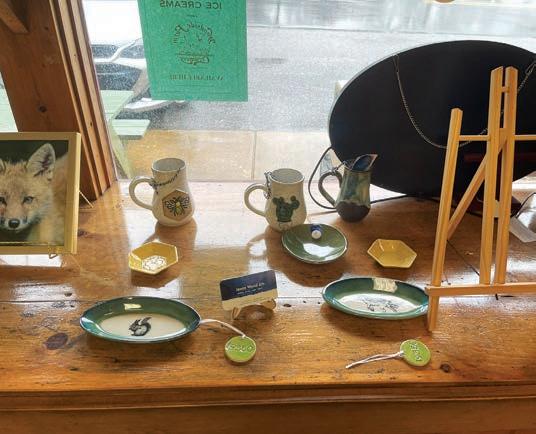
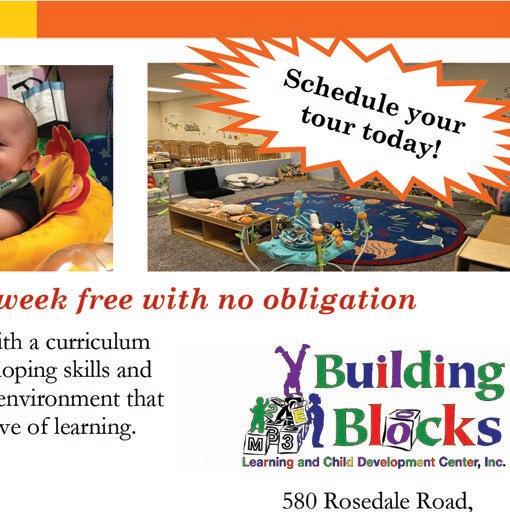

Continued from Page 52
Upon learning that Wood is a local potter, Felch’s daughter Lindsey gifted Wood with some her father’s clay-working tools. Jenny said she cherishes the tools, and she gets a warm feeling every time she uses one of them.
“I feel a sense of connection with this other person who did the same art right where I live,” she said.
When asked which aspect of pottery she loves the most, she replied, “I love everything about it, starting with visualizing a piece, then the feeling of the wet clay in my hands, and especially, the rhythm that develops when I’m working with the clay on the wheel.”
She explained that she ascends into a rhythm when she repeatedly throws the wet clay onto the bat (a flat disk that sits on top of the wheel), and that rhythmic sensation continues as she centers the clay and shapes it into an object.
Wood said the next part of the process is to let a piece air-dry a bit for one or two days, and then she trims and refines it and sometimes adds some underglazes or designs. Seven to 10 days more of drying must take place before the piece can be fired in the kiln. She said this natural air-drying process is very important.
“If a piece still has moisture in it, it will blow up when I fire it in the kiln. Not only will that object be destroyed, but the shattered fragments might ruin other creations that surround it in the kiln,” she said.
Continued on Page 56
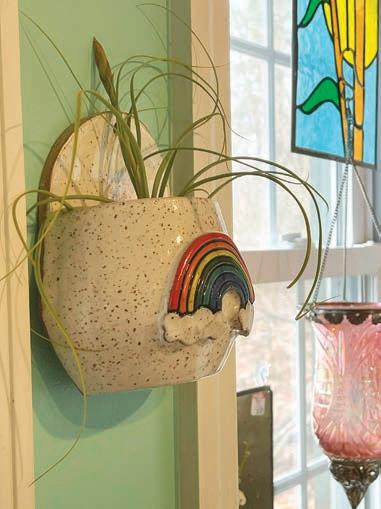

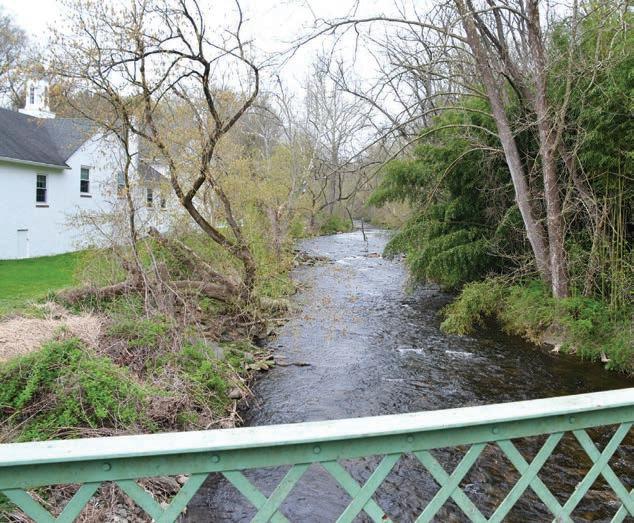

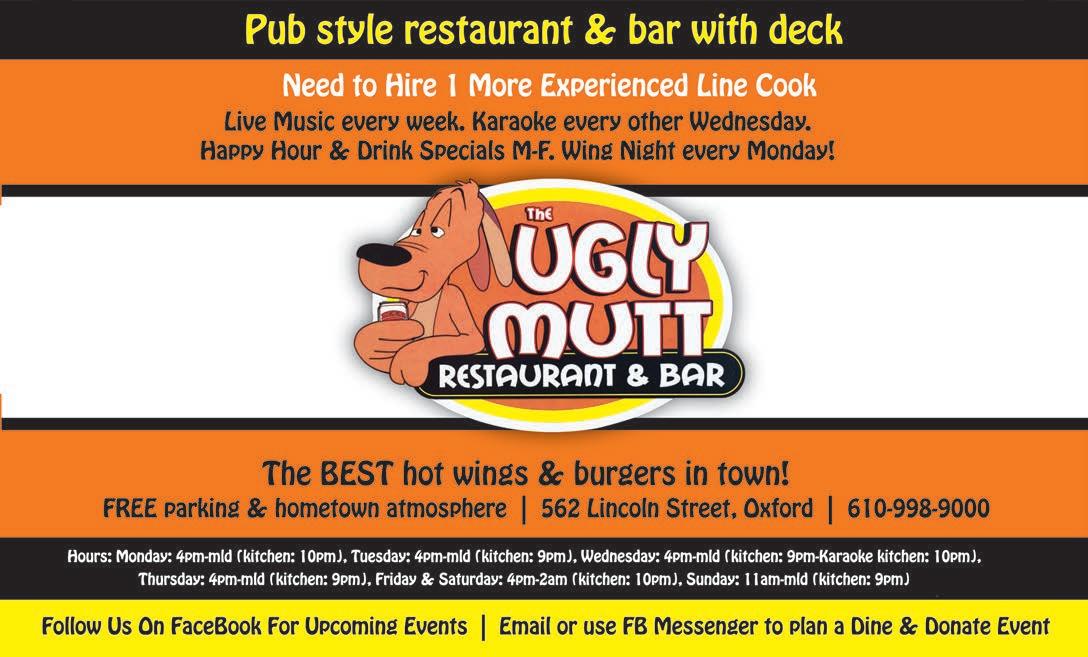
Continued from Page 54
She added, “There is a lot that can go wrong with pottery. A potter has to learn to become very comfortable with failure.”
Wood said that although a piece is typically sufficiently dry after 10 days, it takes about six weeks before a greenware piece (an air-dried but unfired piece) makes it to its first firing (called a bisque firing) in her kiln. She prefers to fill the entire kiln with greenware before she fires it up.
She fully loads the kiln for several reasons. First, she can run it less often if it is filled. Her particular device is very expensive to run because it uses a lot of electricity. Second, the less often she runs the kiln the less likely it is that she will have to replace one of its inner coils (referred to in the business as “elements”). They too can be expensive. Third, running a kiln involves a huge time investment. It remains running for up to 13 hours, and it requires “babysitting.”
Wood explained what she means by babysitting. She said, “For the type of clay I use, cone-6 stoneware, that first firing needs to reach a temperature of 1,945 degrees, and the second firing, the glaze firing, will go all the way up to 2,232 degrees. Depending on the type of clay a person uses, optimal firing temperatures might be higher or lower, but the kiln is always going to pose a potential safety hazard if a person doesn’t keep an eye on it.”
Continued on Page 58


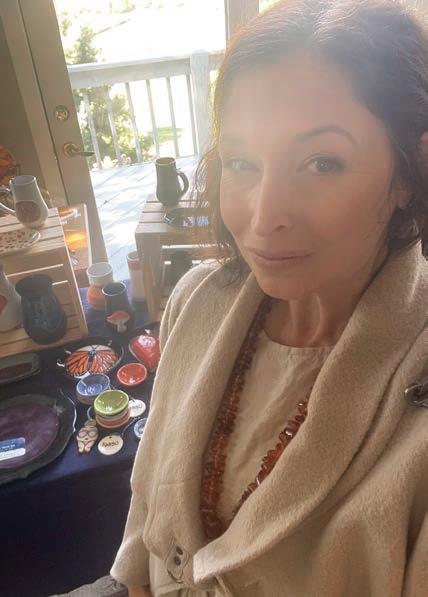


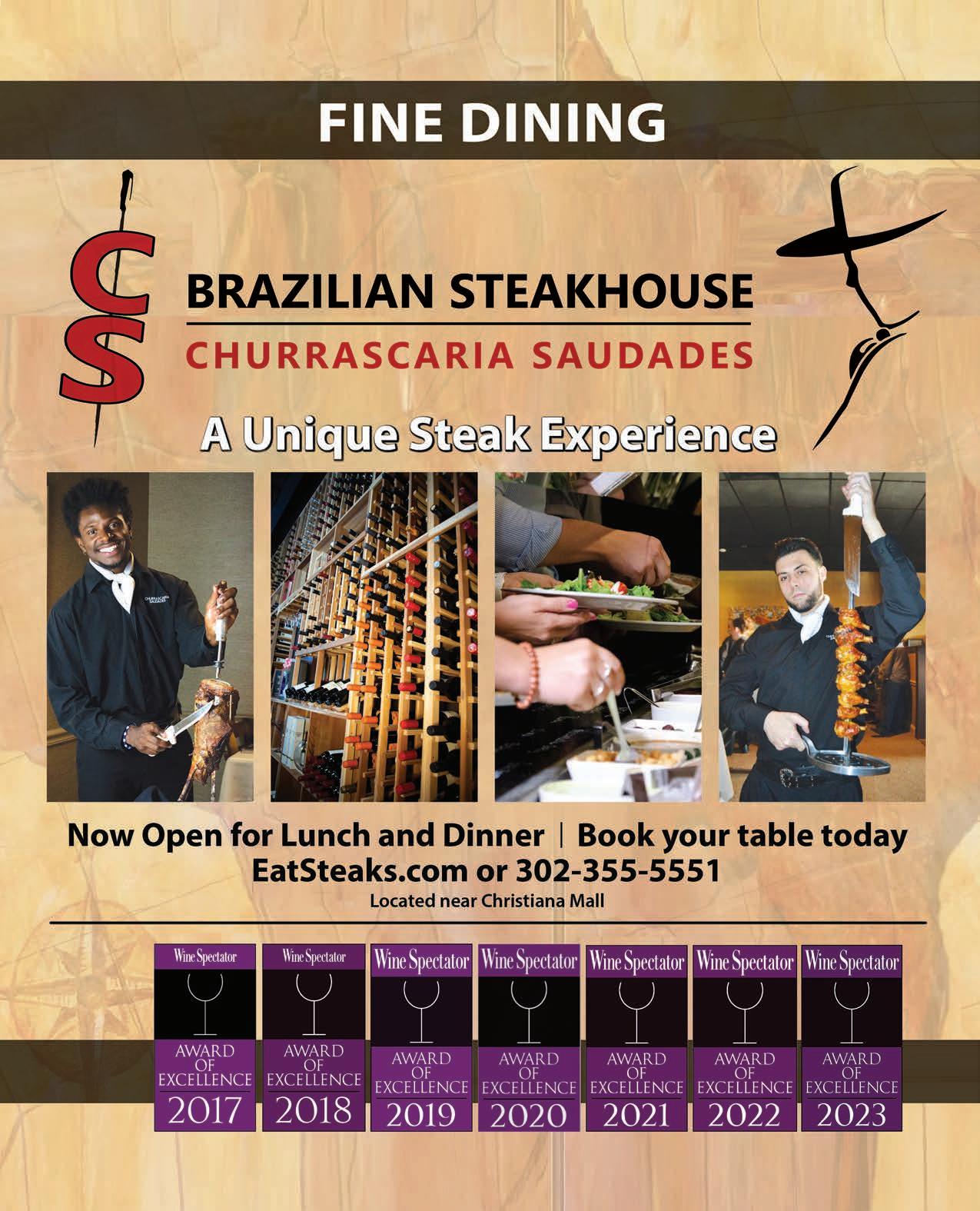
Continued from Page 56
Due to safety and investment concerns, Wood recommends that people new to the art of pottery wait a while before purchasing their own kiln.
“I would recommend people start off by learning how to work with clay and becoming familiar with the various glazes and underglazes before they think about purchasing and operating their own kiln. That’s what I did,” she said, “For years, I just took my air-dried pieces to local pottery shops for firing. There is a steep learning curve to learning how to use and maintain a kiln properly, and that knowledge must be attained in a series of baby steps.”
It is likewise true, Wood said, that there is a point in which an artist, in order to expand and grow, is going to desire to possess their own kiln. She bought her kiln during the pandemic, but only because so many pottery shops had closed down. After slowly learning how to put the kiln together and how to maintain and operate it, she eventually became skilled enough to begin experimenting with different temperature ranges. She discovered that varying the holding times of tempera-
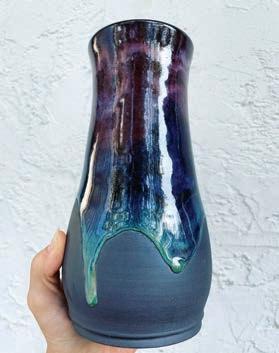
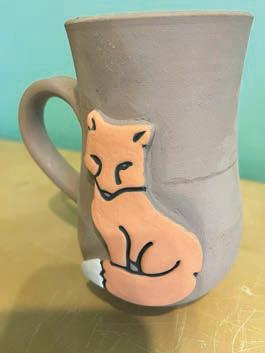
in a whole new world of creative outcomes.
“For instance, once I had my own kiln,” she said, “I discovered that if held a glazed stoneware piece at its highest optimal heat level for five or 10 minutes, rather than letting it reach peak and then immediately cool down, that method slowed the

cooling process and resulted in interesting “drippy” effects on my stoneware, and customers really like those effects.”
Before one of Wood’s pieces can be deemed “complete,” she often embarks on a secret and time-consuming glazing process. One clay vase used 12 layers of glaze, and each layer was fully air-dried before the next layer was applied.
It is a process, she said, that takes days. But the results proved that the time spent was well worth it. The vase had a rainbow, glass-like sheen to it which was quite pretty.
The final step in the process is when a batch of glazed pieces go into the kiln for the second time. And once again, she keeps an eagle eye on the heating process.
When the glaze-fire temperatures go down to a point in which the kiln is cool enough to open, Wood said, “It’s like a holiday! It’s such a great feeling to take out all those pieces that took weeks to make.”
With all the skill, materials, time, and expense that goes into making a piece of pottery, it’s little wonder that one of Wood’s mugs can cost a patron upwards from $40.
Continued on Page 60

Wood displays a photo album of her processes and pieces on Instagram at Jennywoodarts, and she said people are welcome to contact her there if they see a piece they would like to purchase. She also has a website titled Jennywoodarts.com.
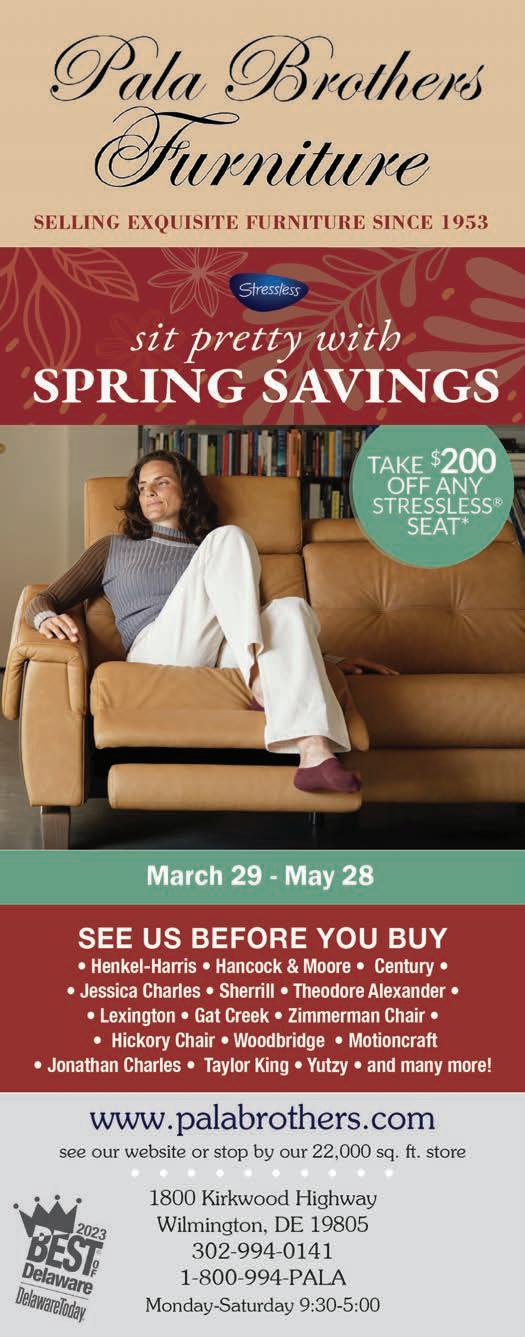
Continued from Page 59
“My prices are probably in the standard range for clayware mugs, and people are more than happy to buy them,” Wood said. “Many people really appreciate the value of a handmade piece. And they like the fact that they are buying something that is one of a kind. No clay piece can ever be precisely duplicated --- there are just too many variables involved.”
During my visit with Wood, she served me kombucha out of one her stoneware mugs. It is a drink of which I am already fond, but I can state with certainty that it tasted even better out of one her mugs. I would describe the flavor as being a little more robust and earthier.
That experience led me to question Wood as to why her clays are designed to make good drinking vessels while some other clay products have a warning that people should not drink from them. She explained that she uses a mid-fire clay, which makes for
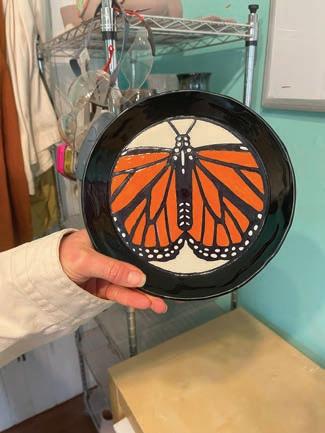
good food- and drink-ware. Some clays, she explained, like terracotta, are lowfire clays, meaning they naturally must be heated at low temperatures. Since they are fired at low temperatures, they remain somewhat porous and moisture retentive, making them great for use as planters but probably not so great for use as drinking cups.
Wood said, “If people want handmade drinking and eating vessels, they should ensure that the clay used is of a type that vitrifies (hardens) at mid-fire and high-fire ranges and inquire whether the potter indeed fired the pieces at those high-heat levels.”
Wood sells her mugs at the shops Rooted in New London, Pa., and Newark, Del., Purple Robin in Lilitz, PA, and The Landenberg Store in Landenberg. She displays a photo album of her processes and pieces on Instagram at Jennywoodarts, and she said


people are welcome to contact her there if they see a piece they would like to purchase. She also has a website: www. jennywoodarts.com.
Her pieces are also sold at various market shows held throughout the year. Last fall, she was a featured artist at the Artists of Landenberg Studio Tour. This show, which enabled people to visit the studios of local artisans, including not just potters and ceramists, but also painters, jewelry makers, and textile designers, was widely popular. It was so well-attended, it will continue on as an annual event. The next studio tour will take place Oct. 12 and 13 this year.
Wood said, “There are endless possibilities with clay,” and she hopes to explore them all. One day, she would like to experiment with using the local wild clays and perhaps try her hand working with different types of kilns. She may even offer some pottery classes in the future. But for right now, she plans to explore, quietly and exuberantly, all alone in her lovely studio in the woods, the fascinating realms her stoneware clay and electric kiln have to offer her.
Jenny’s list of the best places to take pottery classes:
Community Arts Center in Wallingford, Delaware County (Jenny’s favorite)
Centered Clay Studio, Kennett Square, Chester County
The Chester County Art Association, West Chester, Chester County

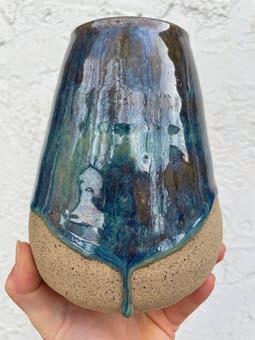


With
vision and patience, Angus Fredenburg and Esther Han have transformed a former sanctuary of faith and art and written a spectacular new chapter

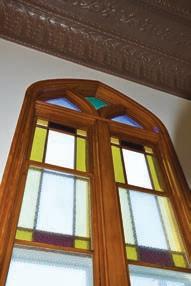
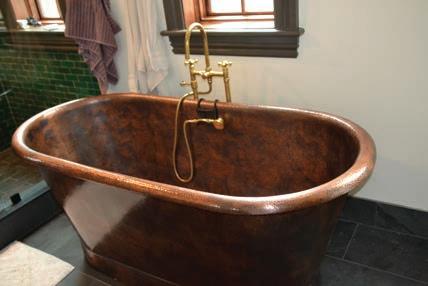
The
By Richard L. Gaw Staff WriterWhen they first drove by the former St. Francis Xavier Catholic Church at the corner of Saw Mill and Landenberg roads in the deep winter of the 2021 pandemic, neither Angus Fredenburg or Esther Han knew that it had once served as a house of faith.
They also did not know that it was once the home of the renowned artist Bernie Felch and his wife Roz duPont, nor that it served as an informal meeting place for a long litany of artists who formed an alchemy of creativity and conversation there.
What first brought the newly married couple to Landenberg was out of necessity. Fredenburg, who was then living in New Hampshire and Han, who was living in northern Manhattan, were seeking to find a house within a 20-minute drive of Esther’s new job as a gynecologic surgeon at Christiana Care in Newark – but as they drove around Landenberg that day – and as their phones buzzed with Zillow postings and GPS directions -- they saw the home for the first time and suddenly, their car made a dramatic U-turn.
They saw its tall spire, the mosaic of its stained-glass windows and the stately front door that had once welcomed parishioners for decades. Immediately, the house exuded the charm, history and majestic possibility that all of the other homes they had visited before did not.
And there it was, in front of one of the most recognizable structures in Landenberg – a ‘For Sale’ sign for everyone driving past it to see…and it was yellow, and because it was yellow, they stopped.
“My parents’ house in Virgnia was red brick and white siding and looked solid and serious, but I always thought that yellow houses were fun and sunny and happy looking,” Esther said. “There weren’t a ton of homes on the market at the time, but before we were to call it quits and go back home, we drew a circle around Wilmington and put ‘Landenberg’ on our GPS and began driving. When we pulled into the driveway, I thought that this was going to be a lot of work. I don’t have the bandwidth or the knowledge to fix houses, but I also knew that Angus loves old houses.”
They called their realtor, and the following weekend, Angus and Esther made an offer on the house. Their nearly two-year journey to turn history into a home was about to begin.
Continued on Page 64
Continued from Page 63
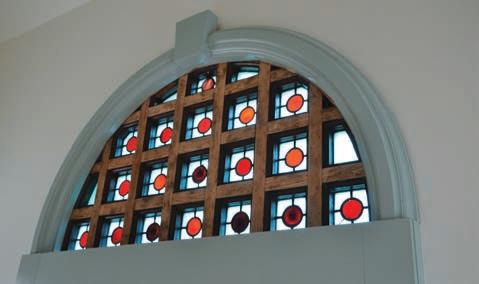
‘His tools are here, and his spirit is everywhere’

Perhaps it is just the simple order of things, but the percentage of couples who begin to envision their lives together by way of an extensive renovation of an old church is measured in the low single digits. There’s a reason for this, and it mostly has to do with the fact that taking on a project of such magnitude requires the organizational skills of a master builder and the patience of several saints. For Angus and Esther, their new living space became a punch
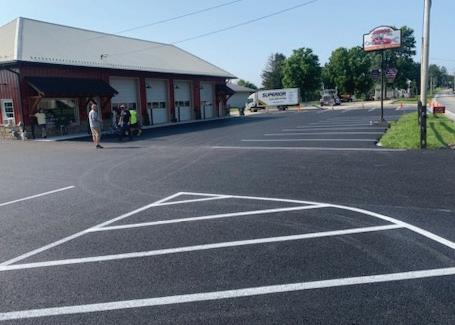

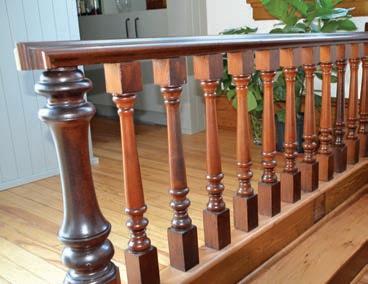
list of crucial overhauls that involved heavy lifting and a serious investment of time. While Esther was at the hospital, Angus and teams of contractors faced the reality of necessity: The electrical units in the church’s stone foundation needed to be upgraded. The flooring needed to be repaired. Walls needed complete replacement. The interior ceiling desperately needed patching. An entirely new roof needed to be installed and everywhere they looked, they saw outdated infrastructure that did not mesh with modern living.
Plan by plan and project by project, the old church began



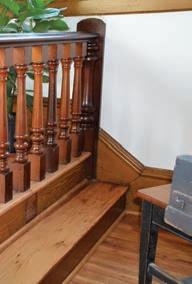
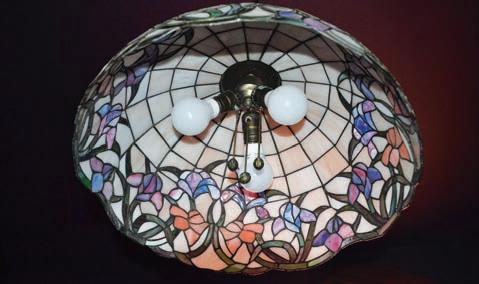
to transform itself from quiet vacancy and memories to one filled with dust and design sketches that reimagined spaces.
Throughout the early stages of its renovation, Angus – an educator by profession -- drew inspiration from his late father, Tom, who retired several years ago from his longterm position as a legal aid attorney in Concord, New Hampshire to start a new career as a home renovator that created housing opportunities for low-income families.
“My father gave me the idea that crazy things like this were possible, and when he died, I inherited a couple of daunt-
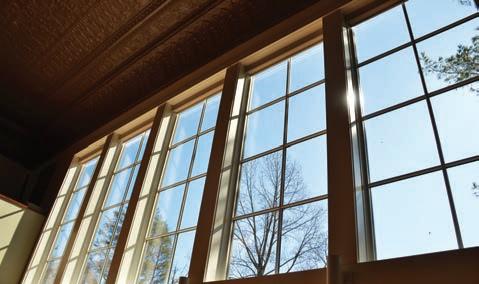
ing home reconstruction projects that were halfway done, so during the pandemic I got to help renovate a home that was built in 1789, nearly by myself,” Angus said. “Esther would check in on me from time to time to see if I was still committed to the project, but I was so excited about it from the get-go. Some of Esther’s friends asked us, ‘Why are you doing this, renovating a church that was built in 1893?’ But those from my family knew that it all made sense, and that my father would have been on board from day one.
Continued on Page 66

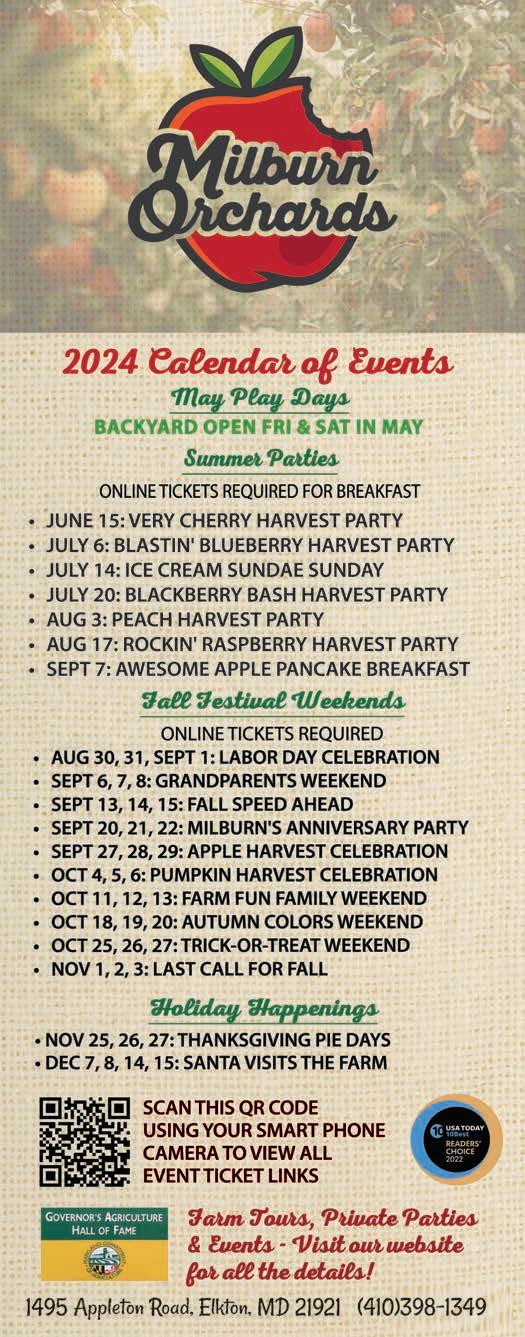
Continued from Page 65
“His tools are here, and his spirit is everywhere. I know it’s true for a lot of people that we eventually turn into our parents, and in my case, I am pleasantly surprised how much I have turned into my father.”
Tom Fredenburg was not the only father who made an imprint on the home’s renovation. Esther’s father CJ – a long-time professional roofer -- oversaw the construction of the metal roof.
“Seeing him here reaffirmed that he knows so much about roofs and about the construction of homes,” she said. “It was fun to have him be here so frequently, because it gave him a reason to see one of his daughters. He would drive three hours from Viriginia, help oversee the construction of the roof, then drive back home so that he could get back to work the next morning.”
Following the completion of the home’s major construction projects, Angus and Esther took on the role of interior designers, adding cosmetic elements like repairing and installing a stained-glass, half-circle window that had been in an 1887 church; and outfitting the home with one-of-akind accent mark accessories like a galvanized steel cabinet they found at a salvage yard in Philadelphia.
What had once been a portion of a cavernous, 22-foothigh ceiling above of the main living space was divided by the installation of a catwalk, and what had once served as the church’s altar was fitted with modern appliances to become an open, airy and natural light-filled kitchen that now welcomes guests, including the nearly 50 friends and relatives who joined Angus and Esther last Thanksgiving.
‘The door was always open’
Lindsey Felch, Bernie’s daughter, lived in the old church off and on for nearly 40 years, as well as in an apartment on the property, beginning when her father purchased the church in the 1960s. It is not entirely coincidental that she has spent her life as an art consultant; the home served as a layover spot and visiting place for Bernie and Roz’s many friends and fellow artists, who would come by the home for four-hour dinners and engage in the language of conversation. There were full bookshelves all around the home, comfortable chairs, and art.
“There were always comings and goings with unbelievably smart, funny, educated, talented, diverse and creative people, and that was just part of life there,” Lindsey said. “The door was always open, and there was never a lock on it.”
During a period when she was living at the home full time, Lindsey and her father engaged in an endless series of puttering tasks around the property – a mended fence, a

newly-built bookcase, a new art installation in one of the work sheds.
“My Dad formed a good portion of who I am today,” she said. “My experience growing up there gave me a comfort level with all kinds of art and various points of view and acceptance. Dad was very much about equality and peace and being creative at every possible moment during the day.
“I remember coming back from months-long visits to other countries and taking my first step inside again and feeling at home.”
After placing the home for sale in 2021, Lindsey heard a myriad of proposed uses for the old church – none of which suited her – and then she met Angus and Esther.
“The book I wrote about my father was on the piano, and it was the first thing they noticed when they saw the church for the first time,” Lindsey said. “Immediately, they fell in love with what my father had done and are very careful about the things that I left there – like my father’s sculptures and walls that are permanent installations.
“They cherish all of it and are great stewards to what was here before them.”
Continued on Page 68
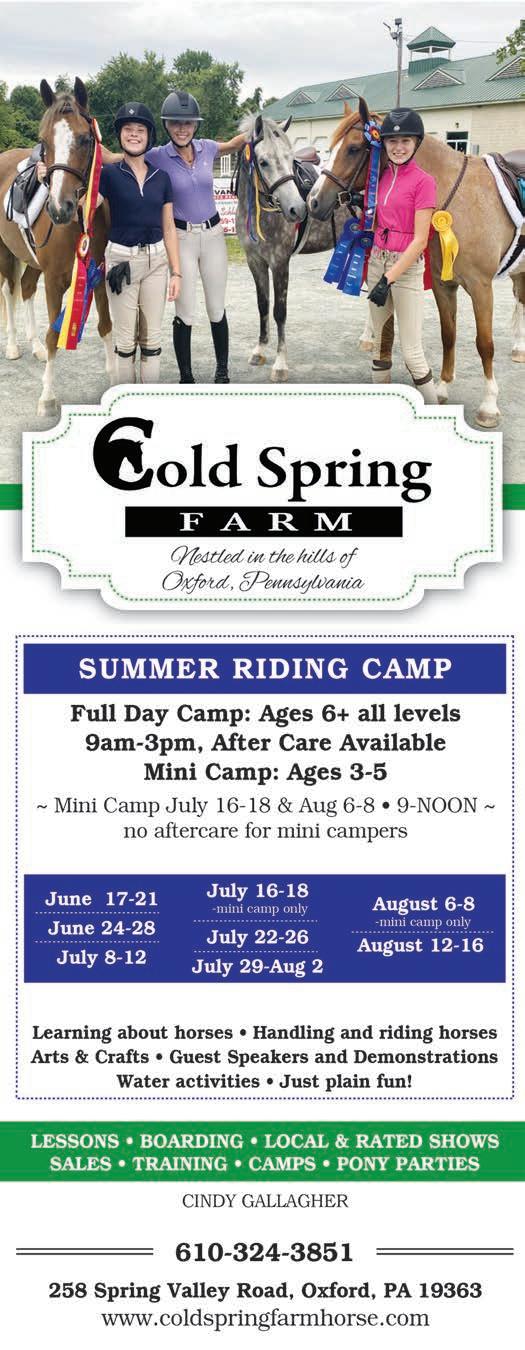
Continued from Page 67
‘This building has a heartbeat’
The time Angus thinks most about his home’s time as a church is when he admires the 16-foot by 20-foot wooden beams that run across the basement ceiling.
“I think about how important this building was to the people who built it and came together in it,” he said. “They weren’t just slapping something together but using the best materials and working with the best tradesmen. Back in the 1890s, when you knew you were going to build a church that would become as important as this would be for the community, you brought in the best people and did the work right.
“When I am there, I am overwhelmed by the sense that the literal and metaphorical foundation of this building is so strong and well-done because it was intended to be an important place for people.”
While they have called the Yellow House their home for the past several months – and although several interior and exterior projects still remain – Angus and Esther said there are moments when they take the time to acknowledge their accomplishment – to give an old church and the long-time
home and studio of an artist – a new chapter.
“Angus and I have lived our lives together in so many different places – from Guatemala to Concord, New Hampshire, where I would visit him -- and from Baltimore to Harlem where he would visit me, but this is our first home together,” Esther said. “After a relationship built over long distances, we get to call this amazing place our home and I feel so lucky.
“This place is still a sanctuary for me -- a quiet place at the end of a stressful day, a place to gather and feed the people I love, a place where our family, our neighbors, and our friends from around the world can come to gather around the woodstove and talk late into the night over a glass of wine.”
“This building has a heartbeat and it’s had a heartbeat throughout its life,” Angus said. “Sometimes new construction can feel cold and impersonal because it hasn’t yet developed that heartbeat, but here, we can definitely feel the energy and the overwhelming deposit of spirit, from the people who have worshipped here and those who have lived here.”
To contact Staff Writer Richard L. Gaw, email rgaw@chestercounty.com.
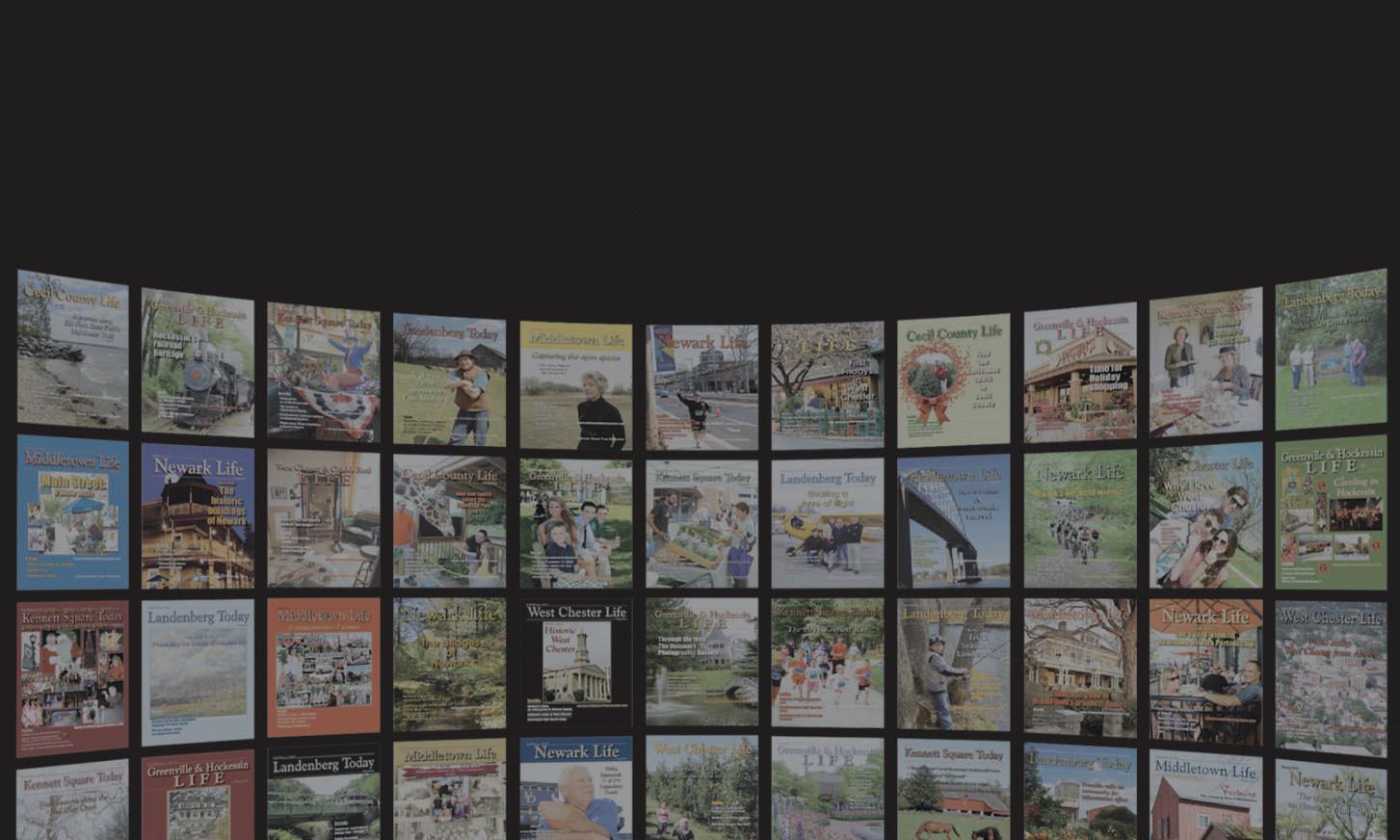







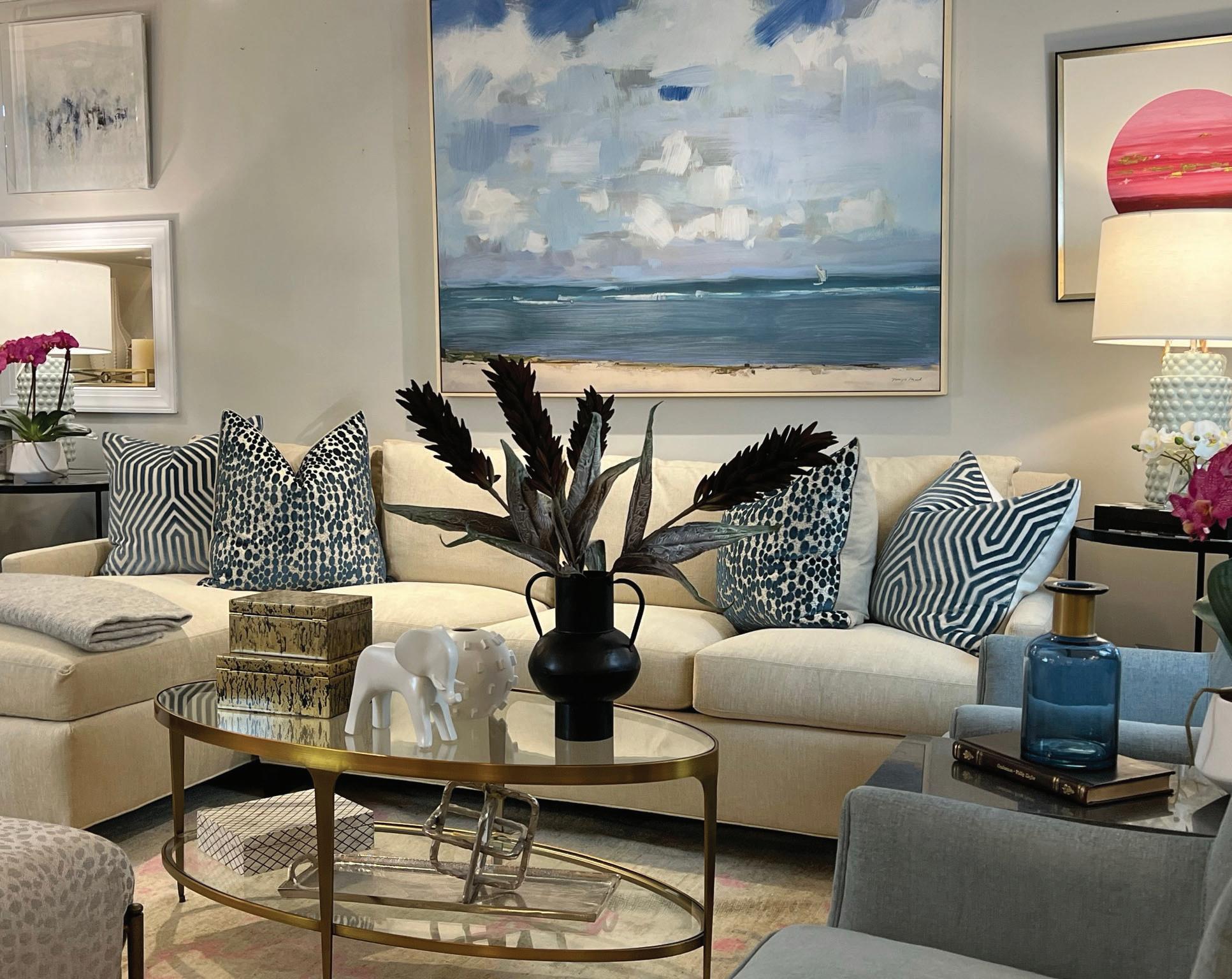




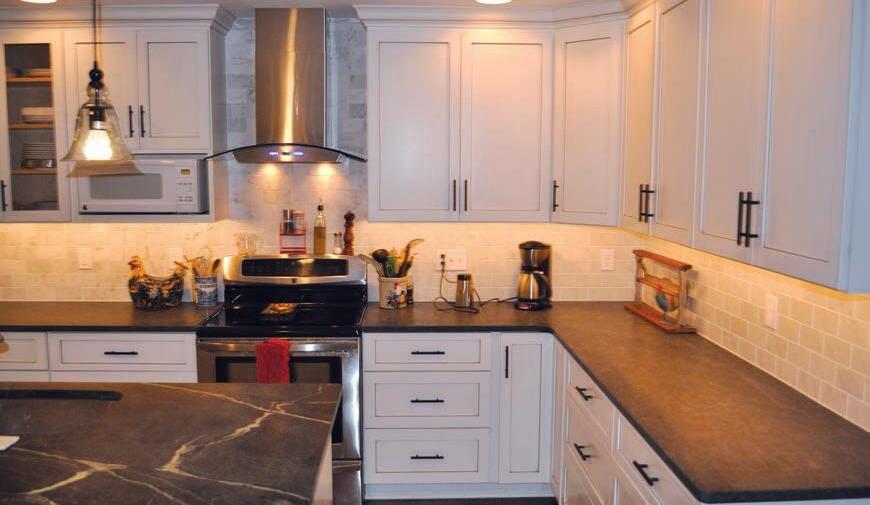
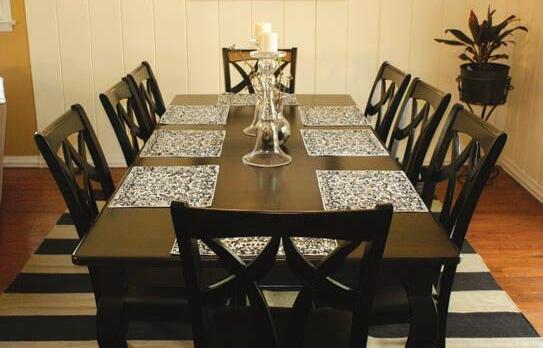

Come and join our great family-owned & operated team

All training is done on site. Enjoy profitable, part-time morning and afternoon employment with nights, weekends and holidays off. Health Insurance is 50% paid for by employer 401K, Hiring Bonus, Retention Bonus Hiring all postions with incentives:
